Jay Fisher - Fine Custom Knives
New to the website? Start Here

"Cassiopeia"
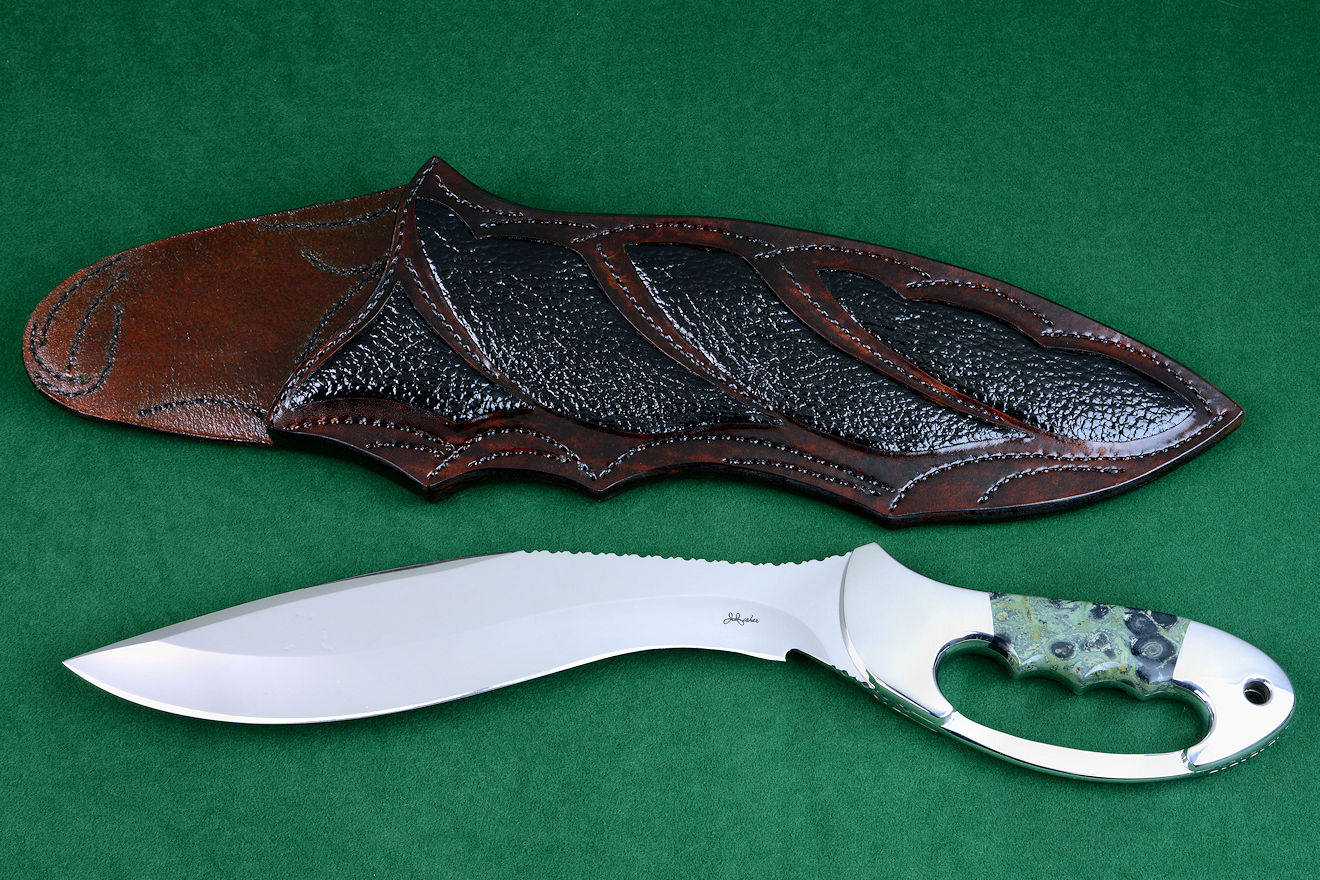
The word "Ananke" originates as the name of a primordial goddess in ancient Greece, as the personification of inevitability, compulsion, and necessity. This is a powerful, beautiful knife, and when the inevitable happens, the blade becomes a necessity and compelled to complete its task. The knife is designed with and made for a very special client with a background of counterterrorism, wilderness encounters, and excellence in knife knowledge. He had a great input on the project, and it was an honor to make this fine, unique knife for his use.
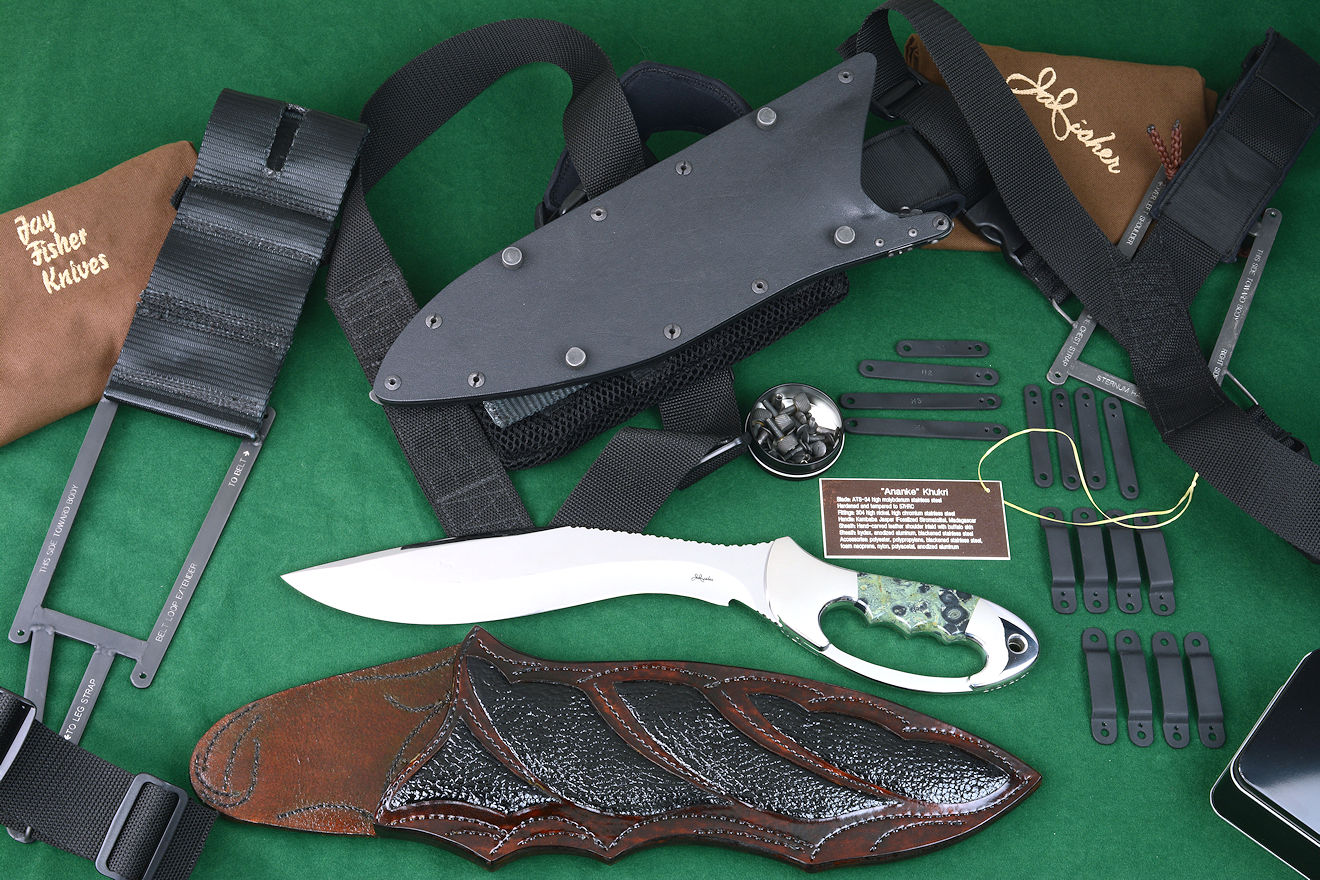
While the custom Ananke is fine enough to be a collector's item, it is also made for tactical, combat, wilderness, and survival use as well. This is the hybridized direction of some of my latest works. Special clients request finely made and finished knives, but also require them to be outfitted and complete with functional, superior tactical and field sheaths and accessories. An extremely fine knife built to the highest quality, with extensive and durable field wearing components are a critical direction of my work. There is no reason a magnificent knife should not be able to withstand the rigors of tactical use, and Ananke was designed with that very purpose. As you read through this page, and view the associated video, it will become clear that beauty, form, and function can work in concert.
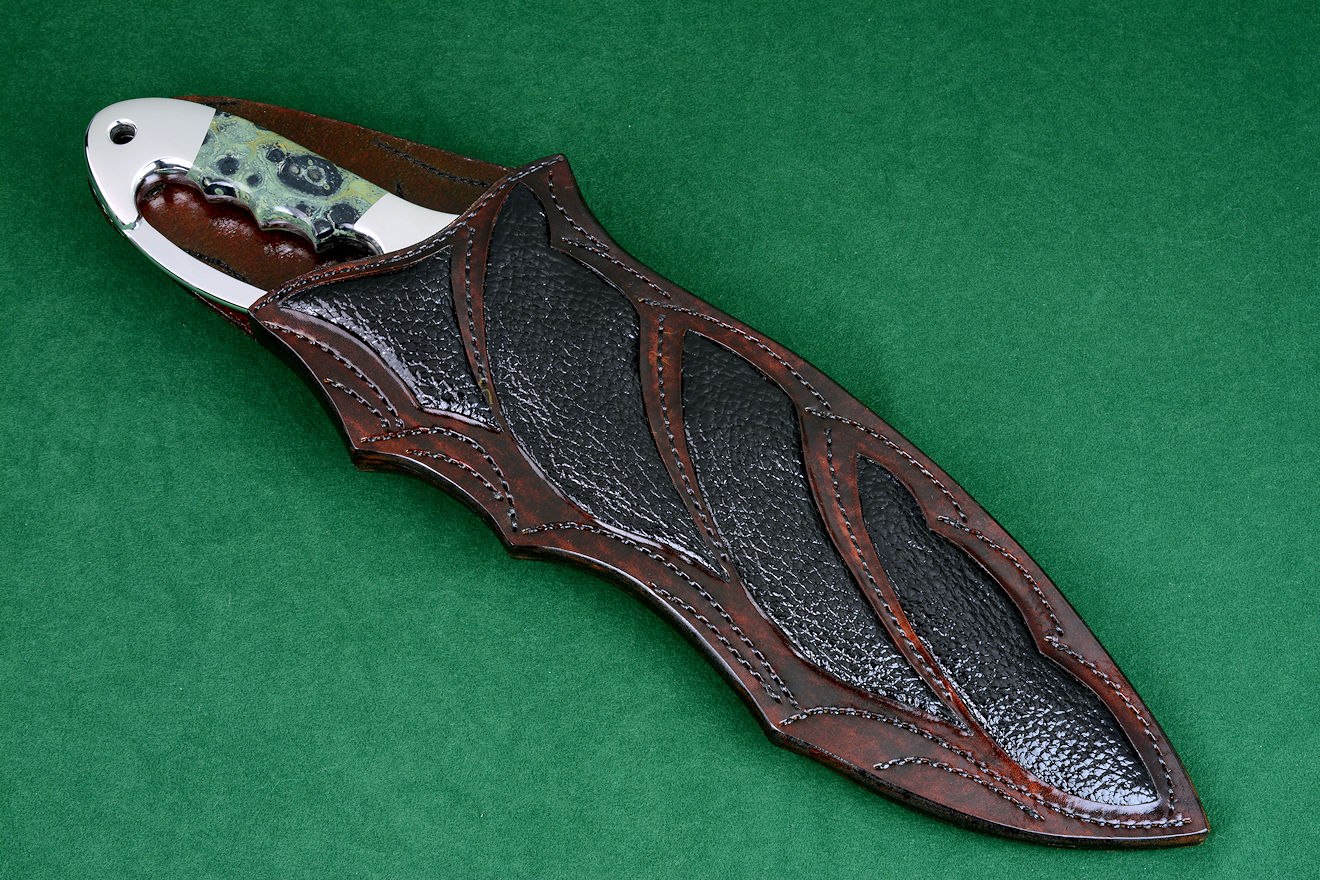
Looking at the Ananke sheathed in meticulously hand-carved leather shoulder demonstrates the very fine work of knifemaking art that I've been blessed to do for the last four decades. My client wanted a refined sheath to accompany this knife in traditional fashion, one not too overstated, but commensurate with the knife. I hand-carved the large sheath in 10 oz. leather shoulder with a dozen sizeable inlays, into which I mounted black glazed buffalo skin panels. The sheath is intensively hand-stitched with black polyester in a curvaceous, artistic fashion, before, during, and after assembly of the sheath. This took some extensive planning, and you can see my drawings of the idea in photos at the bottom of this page.
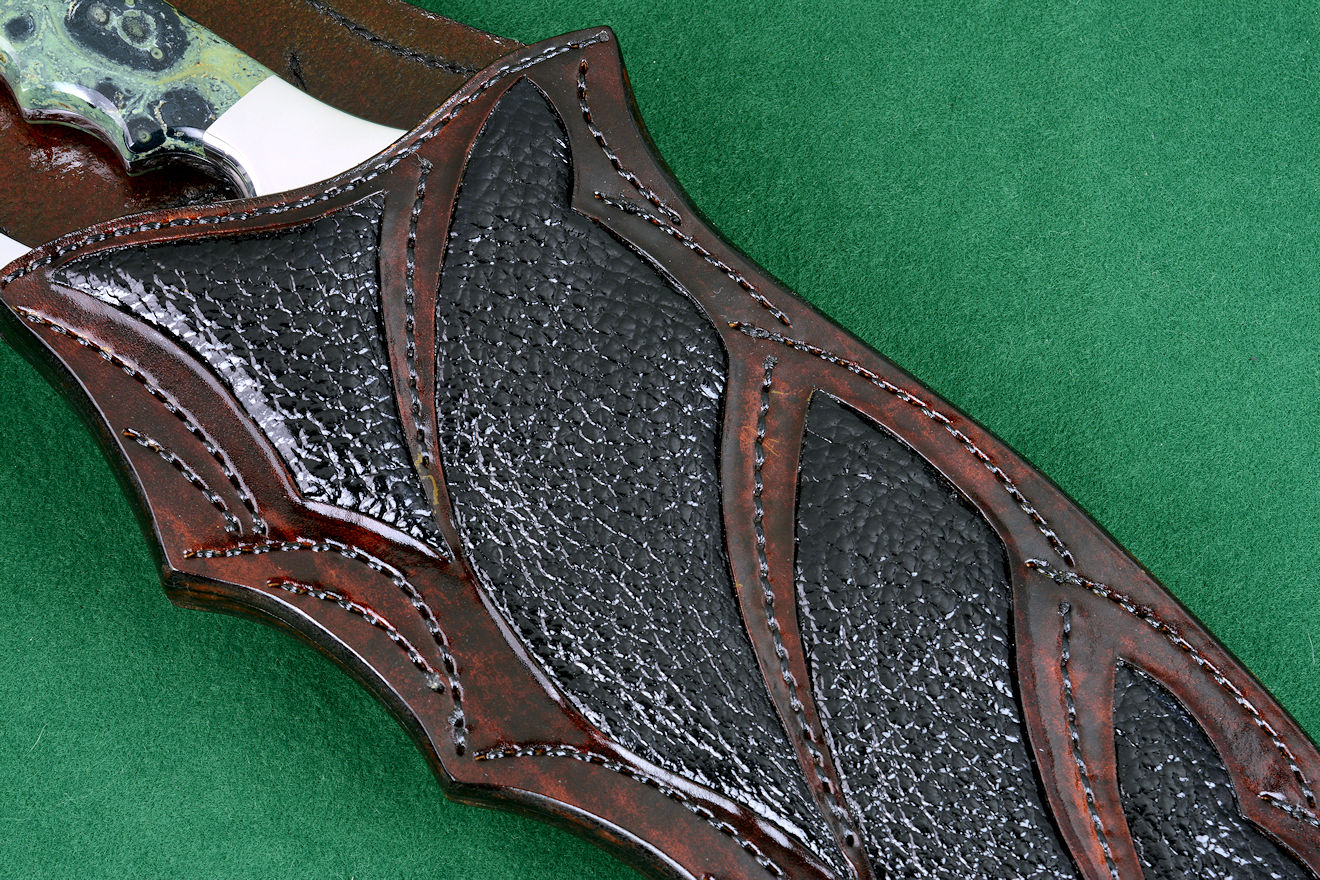
In the photo above, you can see the magnificent texture and appearance of the buffalo skin inlays and stitching arrangement in the sheath front face. Buffalo skin is difficult to work with; it's extremely thick and heavy, and extensive and careful skiving and thinning of the back side of the material was necessary to form-fit it into the inlays. The stitching arrangement was tight and accurate, with curved lines and flowing forms matching the inlay panel shapes. These are all reflected in the overall curves of the knife and its relationship with the fine sheath.
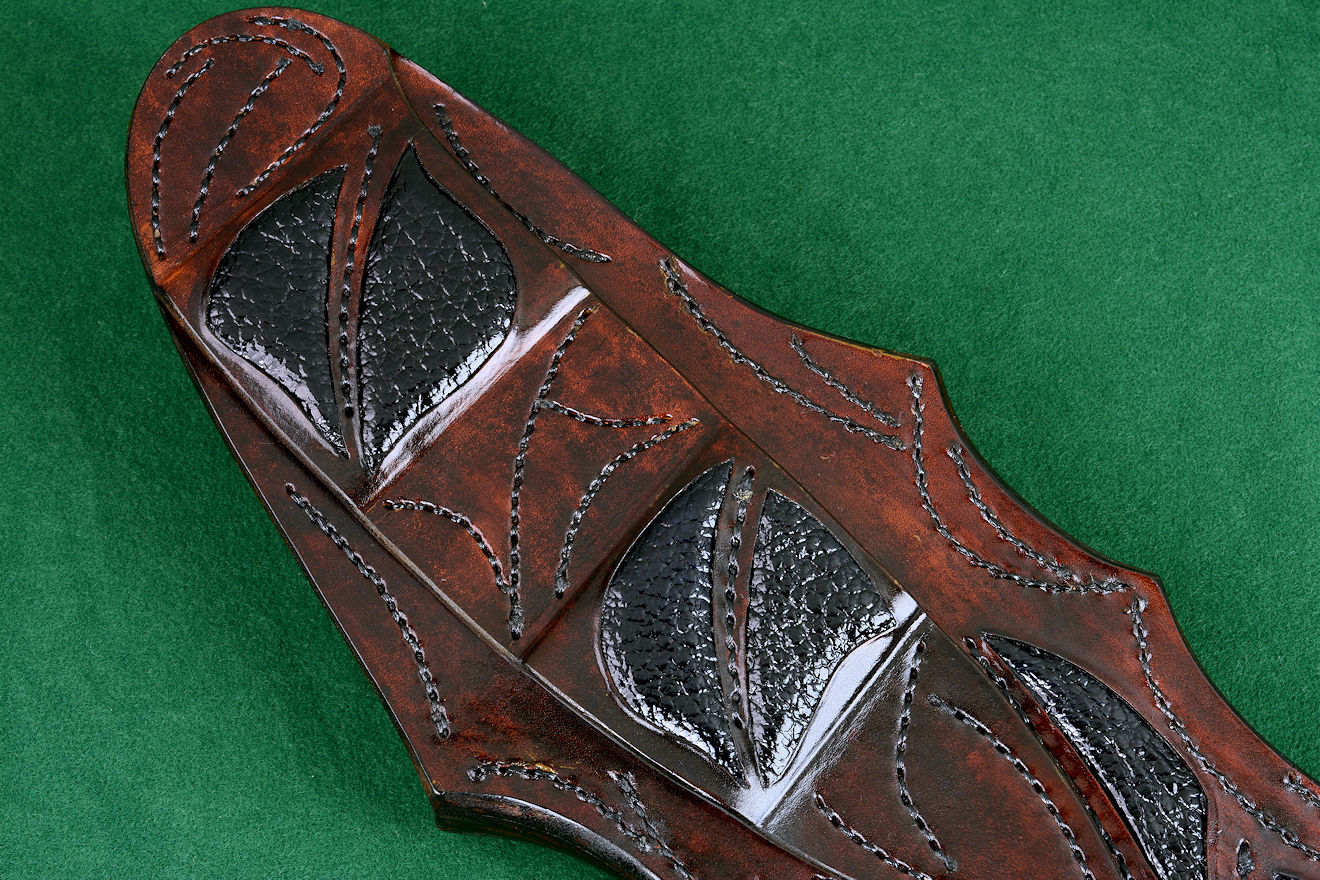
In the photo above, the detail and precision of the back side of the sheath is visible in the double position belt loops. The belt loops are inlaid with buffalo skin as well, and the stitching is artistic and styled to match the design. The heavy leather is dyed a bison brown and the entire sheath is sealed, burnished, and finished to a high lacquered polish for longevity.
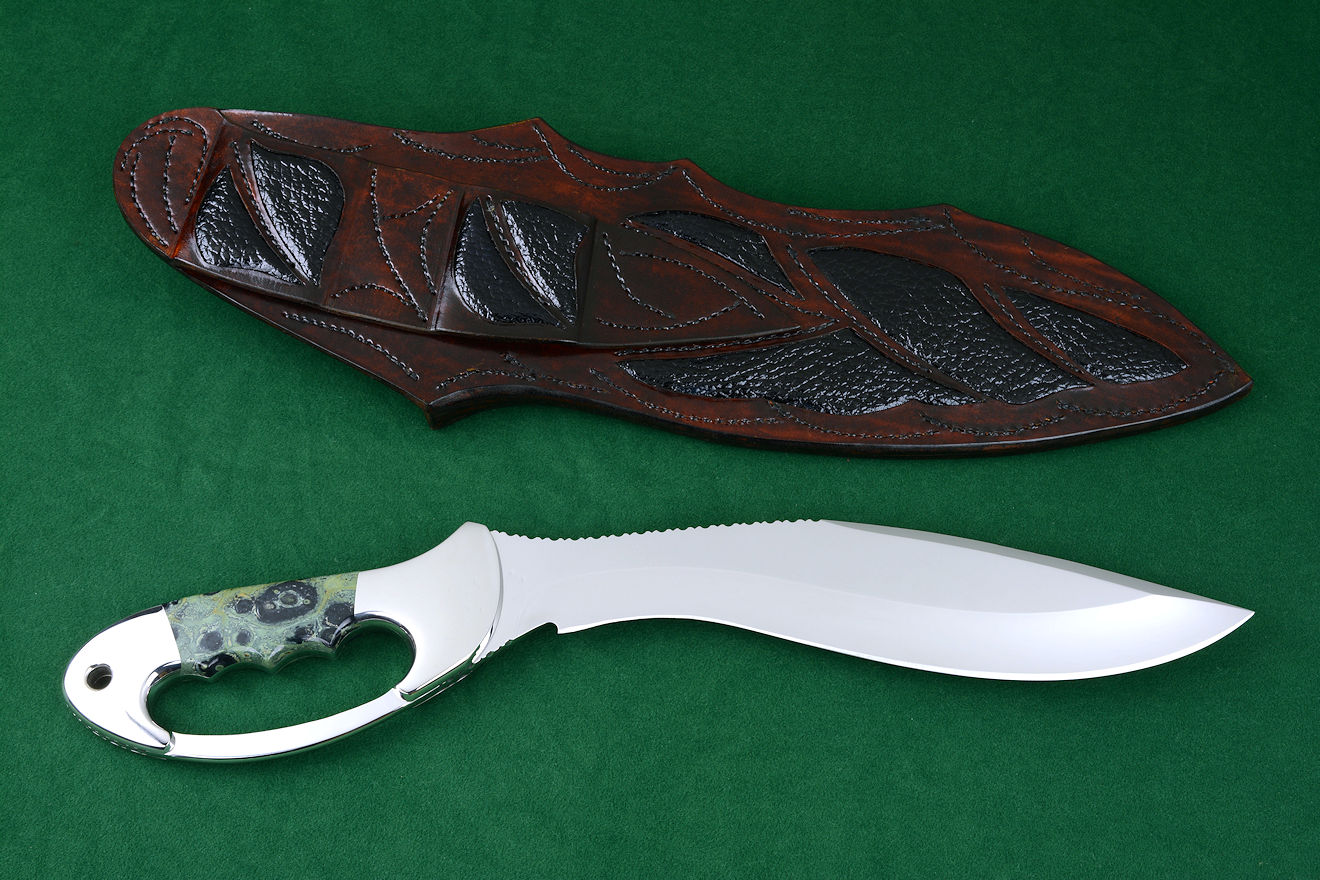
The knife that will reside in both the fine leather sheath and the locking kydex sheath is a beautiful piece of functional steel. The khukri style is distinctive and has its historical roots in the Egyptian kopesh, and earlier forms in antiquity. The forward sweeping recurve blade is a unique identifier, as is the sizeable length and heft. The large belly of the blade allows a forward center of percussion and the angle of the handle-to-blade gives the wrist an improved position over straight blades.
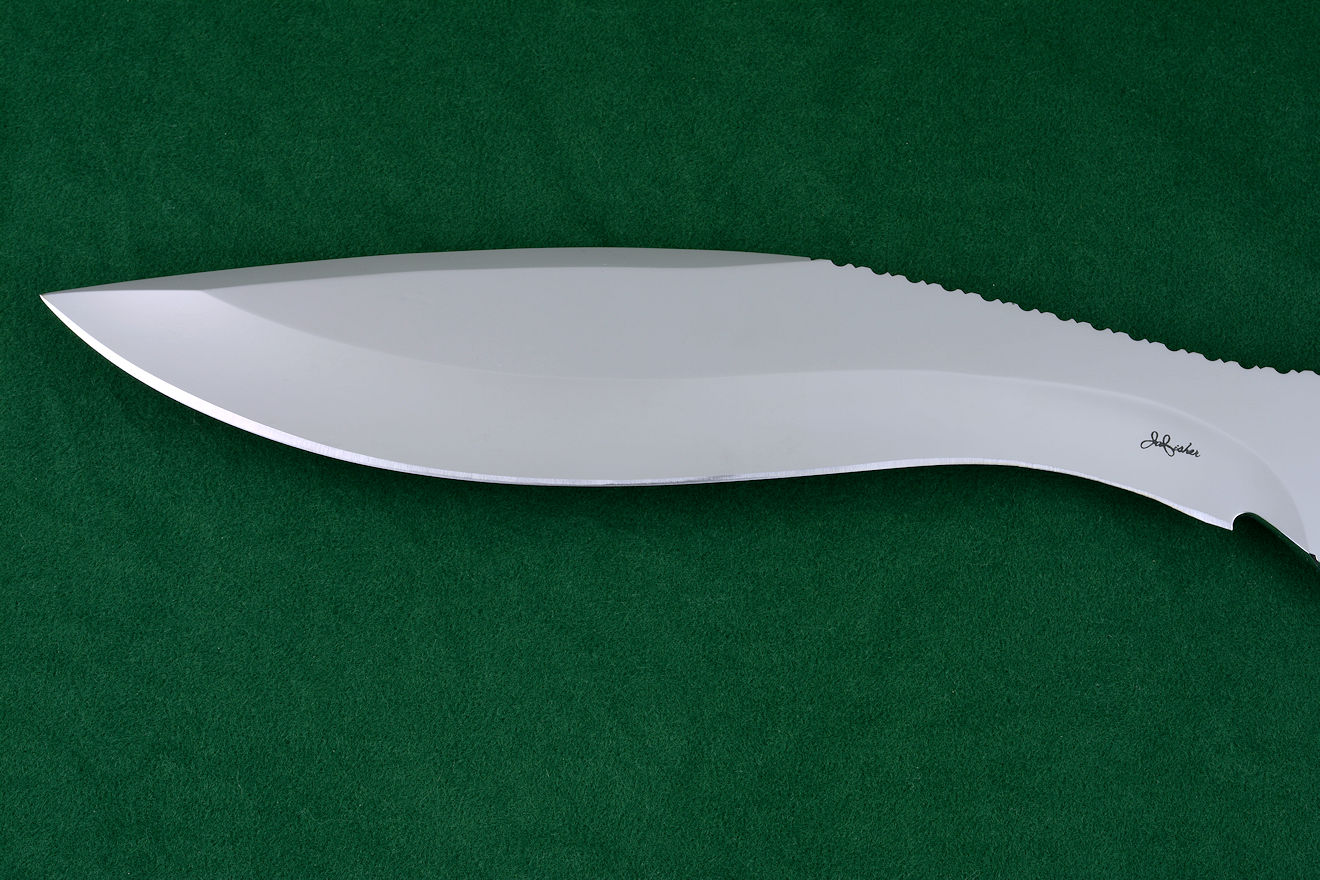
For the blade, I chose ATS-34 high molybdenum stainless steel, and sub-zero processing in the heat treating with triple tempering for maximum toughness of the blade. The high molybdenum in this blade contributes greatly to the toughness, and the alloy is very wear resistant as well. I hollow ground the blade accurately, while leaving adequate thickness at the edge to support the weight of the blade during a cut. This is not a chopping tool or an axe, it's a very large and razor-keen knife. The point is strong yet reduced in profile with the top swage, and the recurve area is double-convex in geometry for an incredibly thin cutting edge, something fine khukris are known for. The massive spine flat supports the entire blade, which is finished to a mirror polish for corrosion resistance, easy cleaning, and beauty.
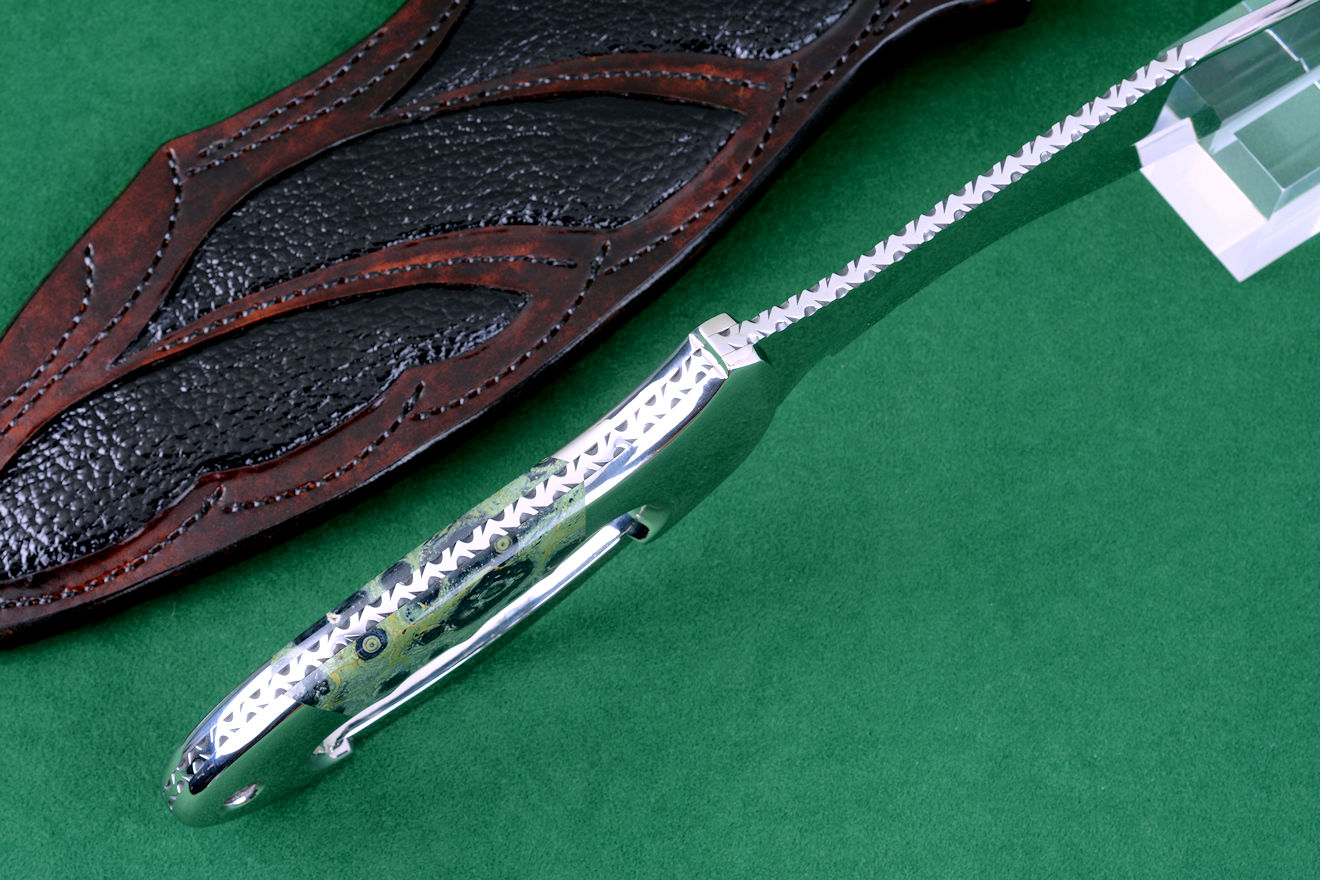
For handmade distinction, I chose a simplex vine filework pattern, and slightly tapered the tang for just the right weight balance with plenty of strength and support. The knife has a solid thumb rise support and the blade spine is thick and strong. The bolsters are dovetailed to bed the gemstone handle scales and lock them rigidly to the tang.
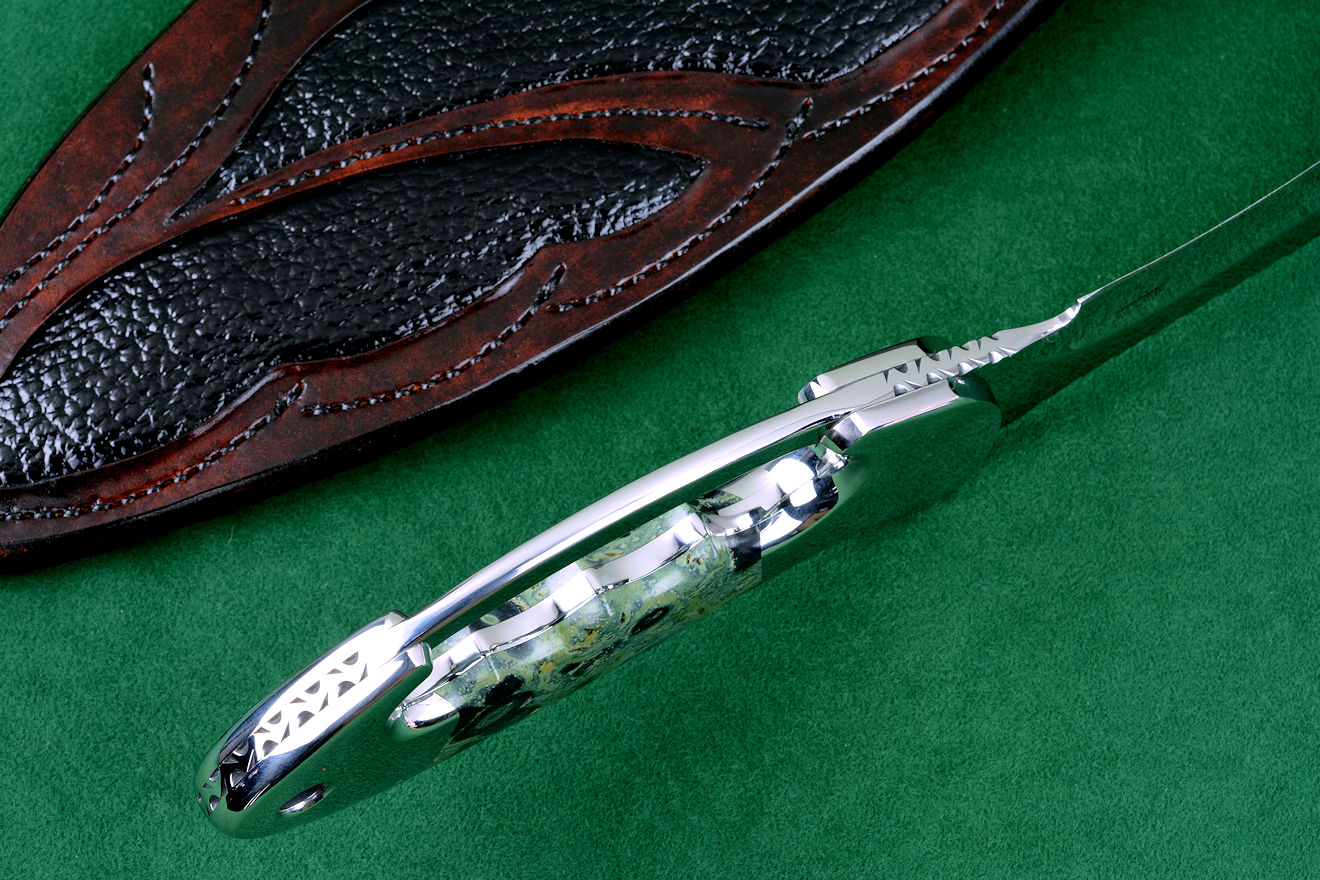
The "Ananke" design is unique in that it incorporates a "D"-ring hand guard. This integral part of the tang wraps around the fist when gripping the knife, offering additional security and strength. The bolsters and the entire handle are polished, smoothed, contoured and finished for a corrosion resistant, durable surface without any sharp corners, edges, or rough areas for the hand. The deep finger grooves in the handle make a certain and sure grip.
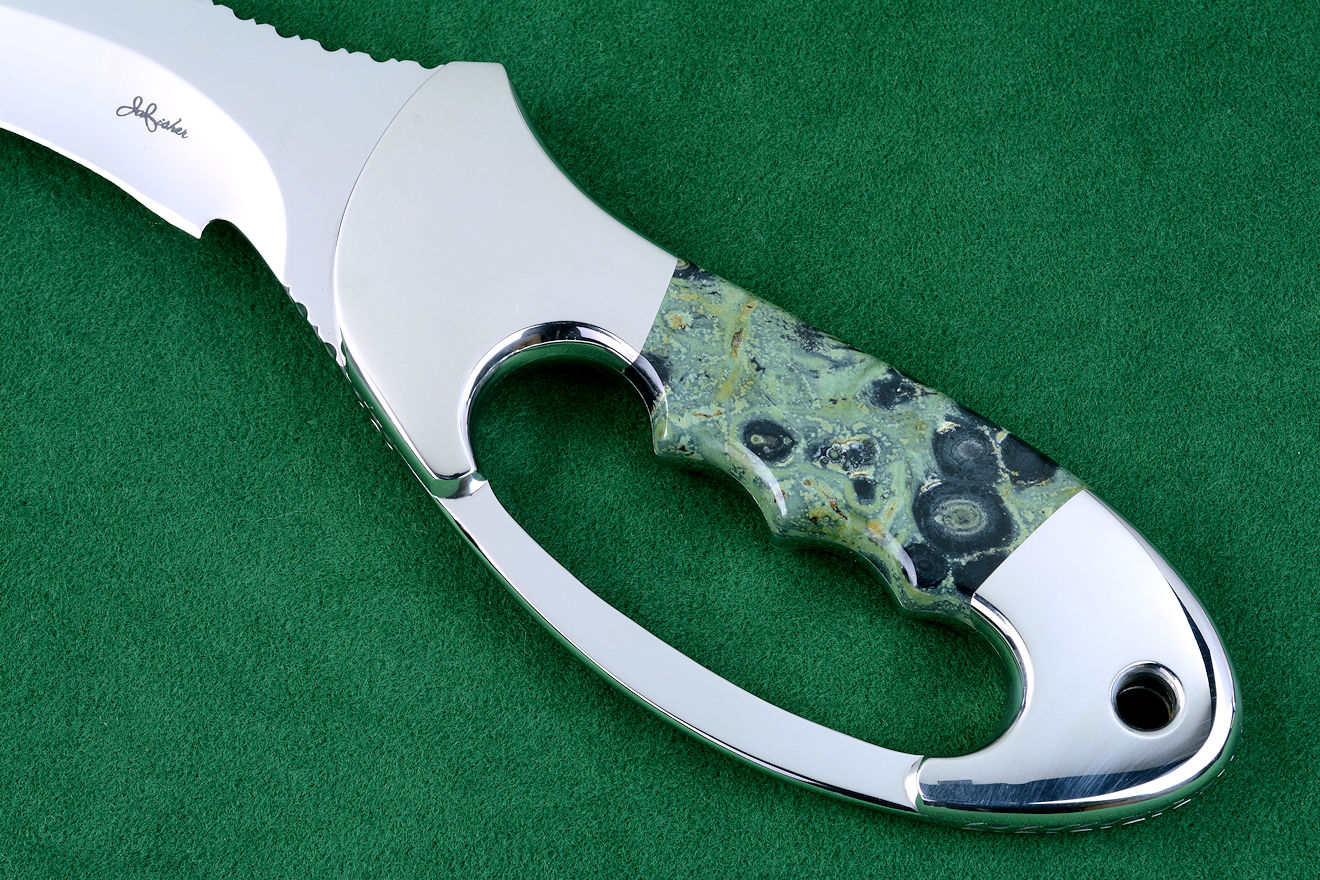
The knife handle is bolstered with my favorite bolster material, 304 austenitic, high nickel, high chromium stainless steel. Also known as 18-8 stainless (for the percentages of chromium and nickel), it is the same stainless steel used in stainless nuts, bolts, and fasteners. It's extremely tough and durable, and incredibly corrosion resistant. I've secured the bolsters with zero-clearance peened pins, and polished the steel throughout. The rear bolster has a chamfered lanyard hole for extra security, and the handle is comfortable and secure.
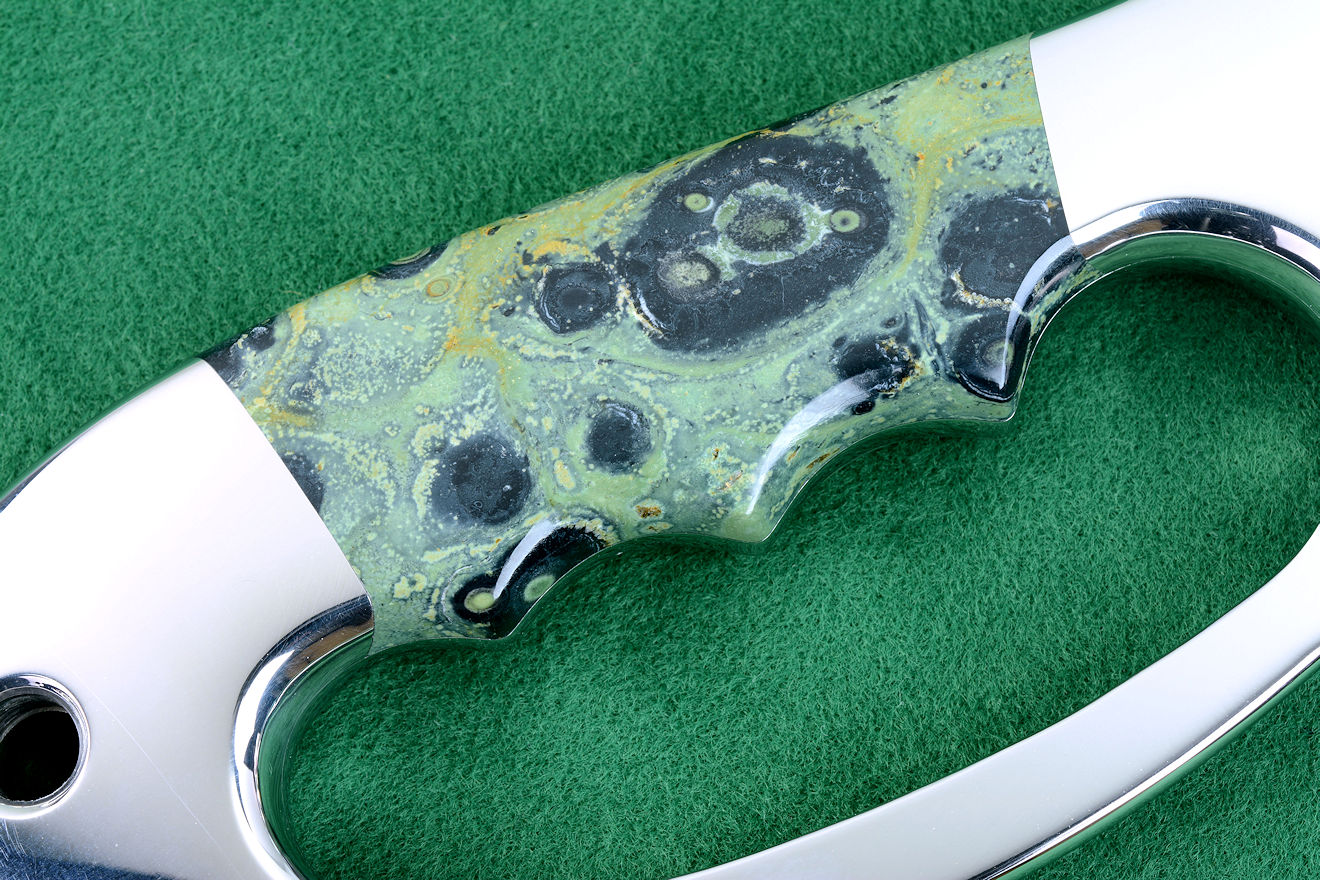
The handle chosen for this khukri is Kambaba Jasper originating in Madagascar. This is a true jasper, a cryptocrystalline quartz, literally billions of years old. Kambaba jasper is fossilized stromatolite cyanobacteria. Often called algae (though not quite biologically and technically correct), they are the earliest fossilized biological remains on earth. The ancient life form was replaced through fossilization, and the patterns and shapes of bacterial colonies are preserved. This is a very hard, very tough gem and will withstand heavy use. In fact, this material will outlast the entire knife, since it is stone. Considering the intense age (about 3.5 billion years), this is not a material that's going away soon! While mostly quartzite, the orange hue is iron sulfide. At that time, when this simple life form ruled the earth, the oceans were filled with iron, and there was little oxygen in the air. It's through this cyanobacterial photosynthesis action that our oxygen-rich atmosphere was created. This is known as the "great oxygenation event." Also called the "rusting" event, it had the effect of turning a lot of iron on the surface of the planet to iron oxides and iron compounds, so the bit of iron sulfide in the stone tells a characteristic story.
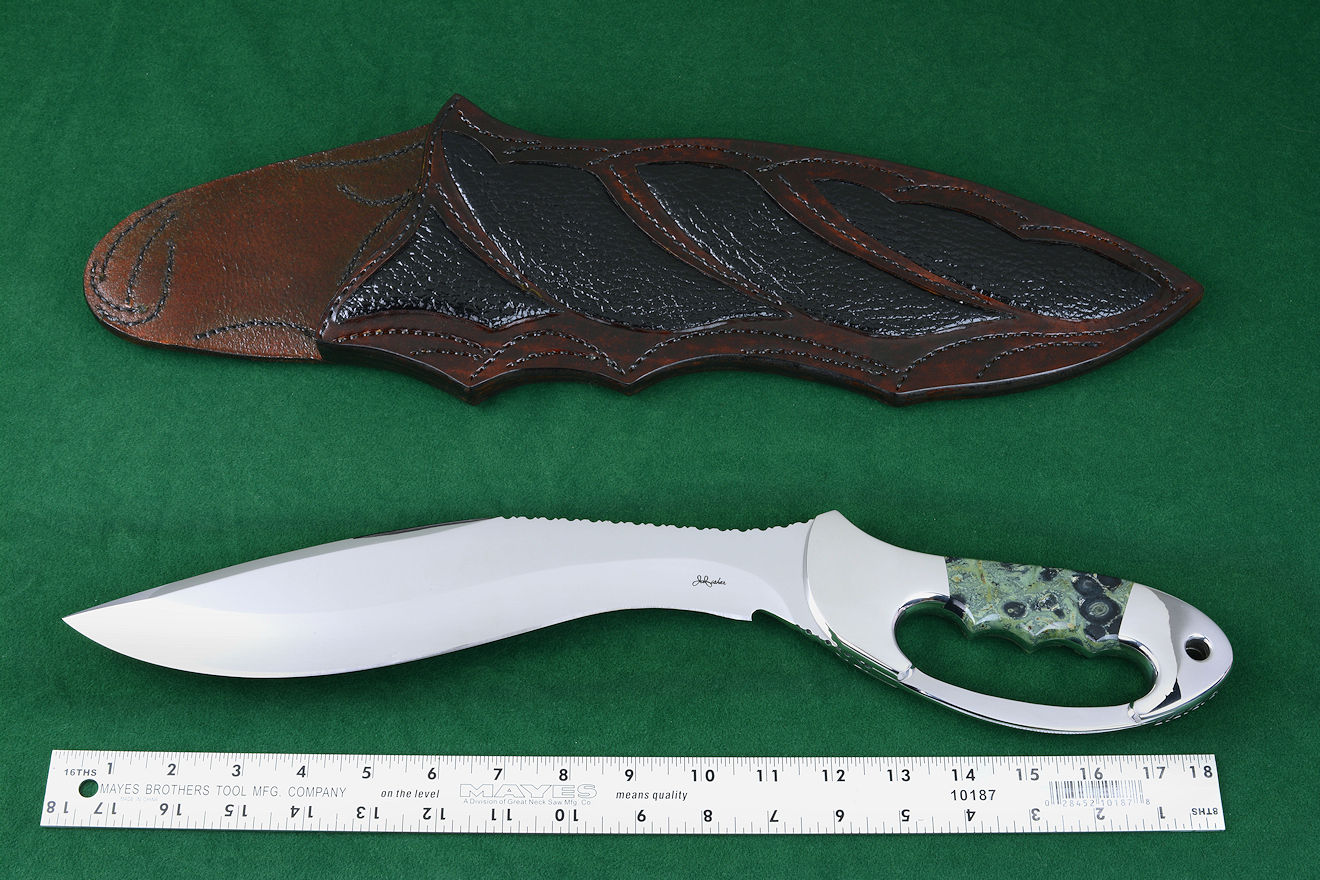
The "Ananke" khukri is a large knife. The overall length is 18.5" or 47 cm. Since the blade is almost 12" long to the front bolster face, it's an extremely serious piece of metal. It was quite intense grinding, shaping, and finishing this hard, tough, and refractory piece of specialized tool steel alloy, and I'm proud that my client chose me to make this knife for him.
Now, let's get into the tactical side of this knife and all of the specialized gear accommodating it.
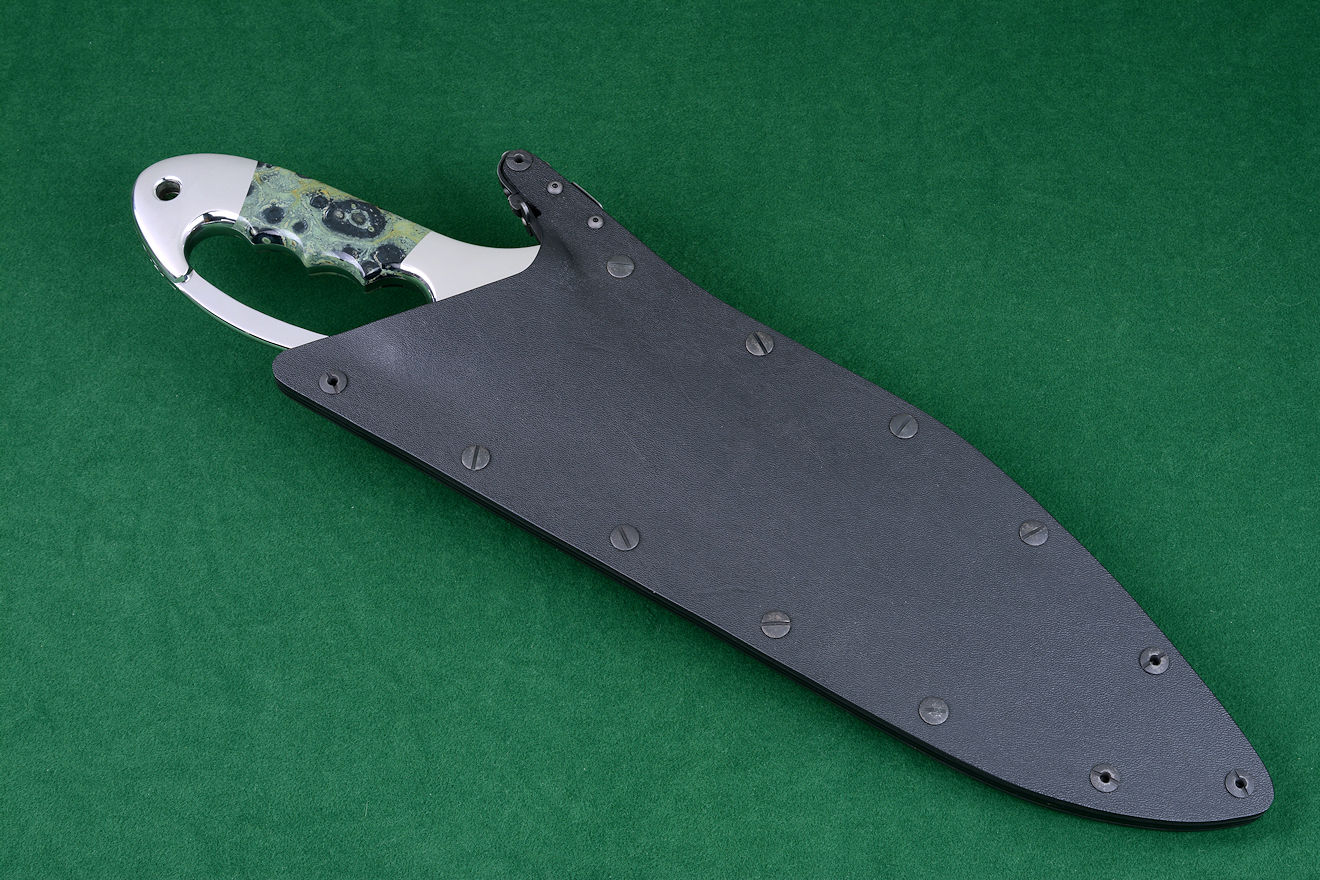
The "Ananke" custom khukri in the positively locking sheath. The sheath is constructed of double thickness kydex, .125" thick, whereas most makers only use kydex half this thickness. Kydex is a thermoforming blend of polyvinylchloride and acrylic, and is extremely durable in thick sections, impervious to all common chemical exposures. The sheath front and back are built on a frame of 5052 H32 corrosion resistant, high strength aluminum alloy, and I've anodized the aluminum with a permanent, near-ceramic hard coating, into which is sealed the black dye. This makes the aluminum even more resilient, scratch resistant, and corrosion resistant: the best it can be. It's also flat and non-reflective. The aluminum welt frame supports the multi-component locking system, made of all stainless steel (304, 302, and 316) for the highest strength and corrosion resistance. I've made these locking sheaths for military and tactical use since 1994, and have not had a failure of a single one. The sheath is secured with all 304 stainless steel hardware and fasteners, which have been blasted for glare reduction and treated with a black oxide finish that darkens the stainless steel.
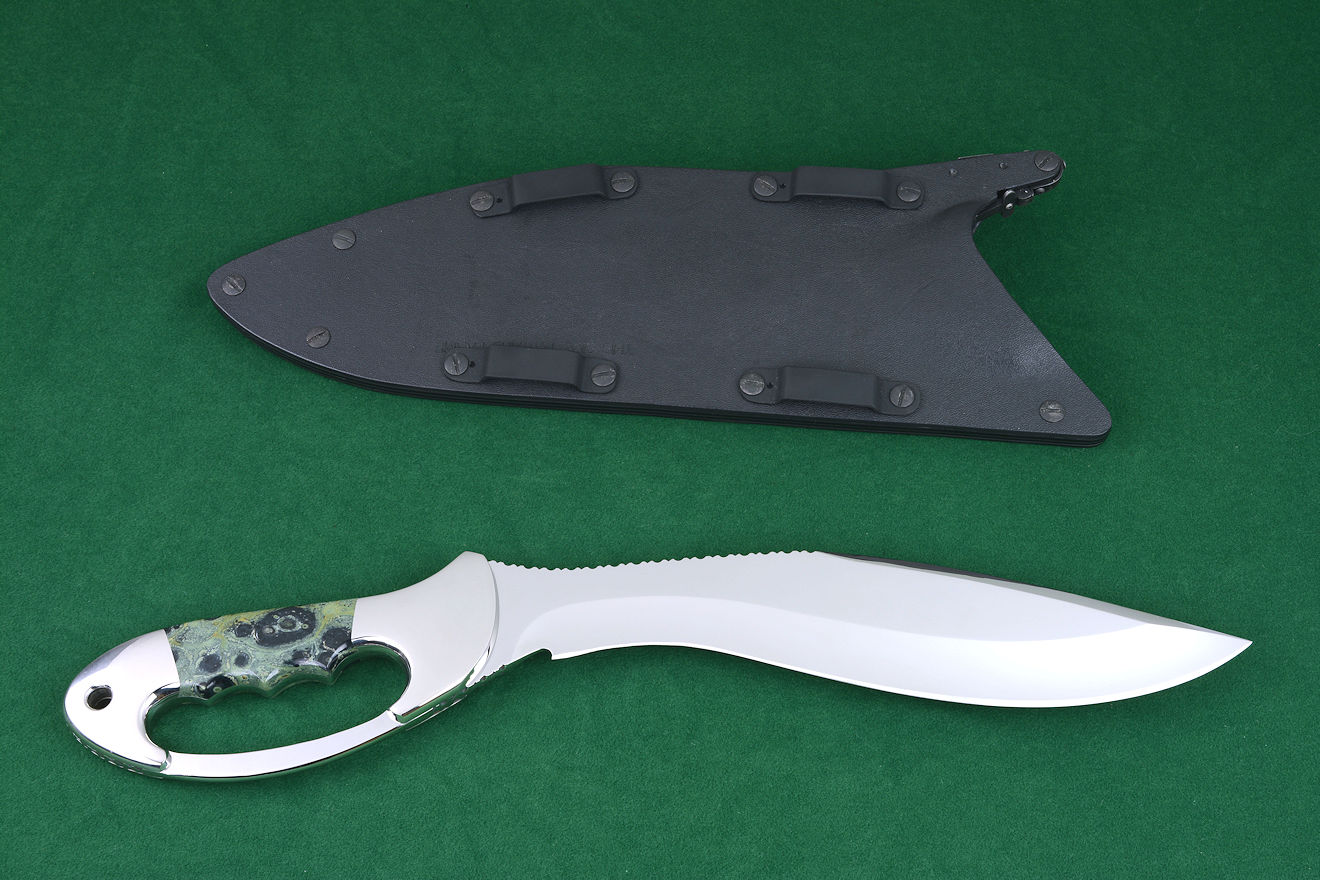
Above is the reverse side of the sheath shown with typical belt loop mounts. This is a large unit and I've included lots of mounting accessories. The standard belt loop is a die-formed strap of black anodized 5052 aluminum, drilled and formed to accommodate various positions on the sheath. The belt loops come in two sets of four each, one set fitting a .190" maximum thickness belt with 1.5" maximum width, and the other set of four accommodating a maximum belt size of .250" thick and 1.5" wide. The loops (also called "footman's loops" seen on old steamer trunks) can be bolted anywhere along the frame of the sheath body and on either side, wherever the 2.5" hole spacing occurs. This allows a variety of loop mount options for the wearer.
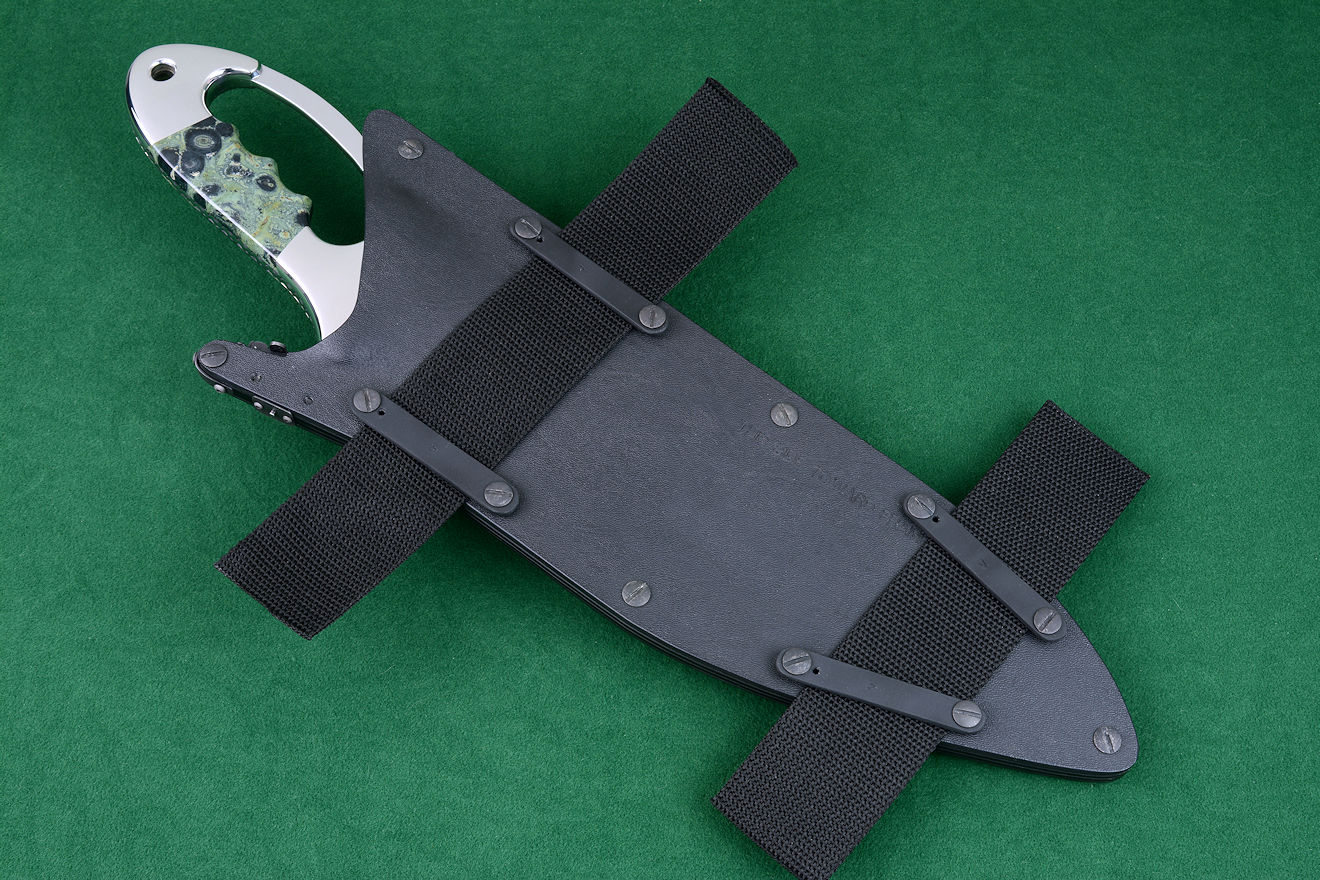
In the photo above, I've set up the included vertical clamp strap option. Unlike the belt loops which allow the sheath to slide around on the belt, these are thick (.125") anodized black aluminum clamping straps. When positioned on a belt, web, or pack component and screwed tightly, they clamp the sheath into a fixed position. These vertical straps are stamped with a "V" for identification, and fit the standard 2.5" hole spacing along the sheath. As demonstrated in this photo, they can accommodate a 2" wide webbing strap.
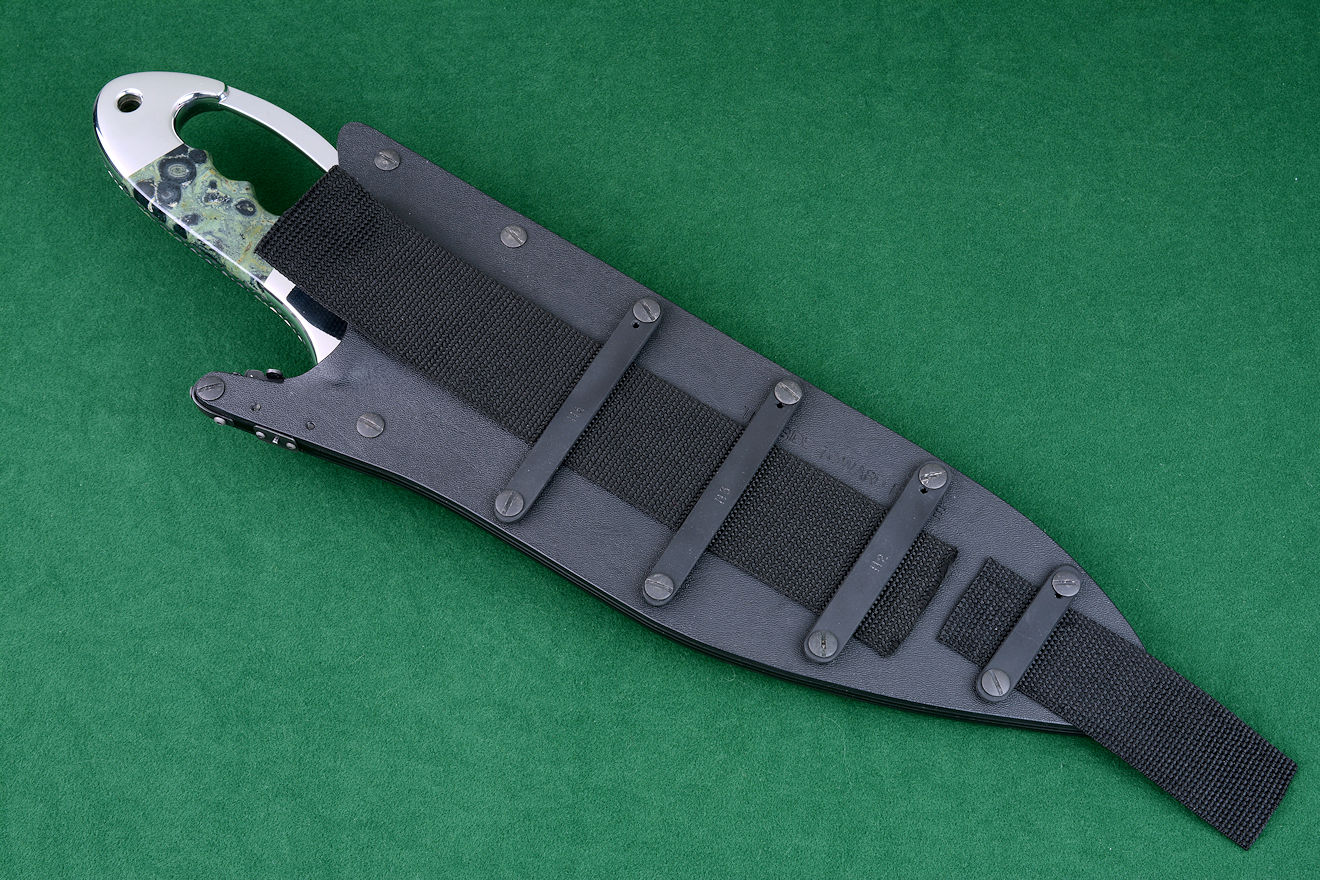
In the photo above are shown the horizontal clamping straps. Like the vertical clamp straps, they clamp rigidly to the sheath body, and will accommodate a variety of strap sizes and positions. They are stamped H1-H4 since the bolt spacing varies along the sheath width. The larger straps will accommodate 2" (shown) and wider straps, the small strap at the tail of the sheath will accommodate a maximum of 1.5" wide strap (shown).
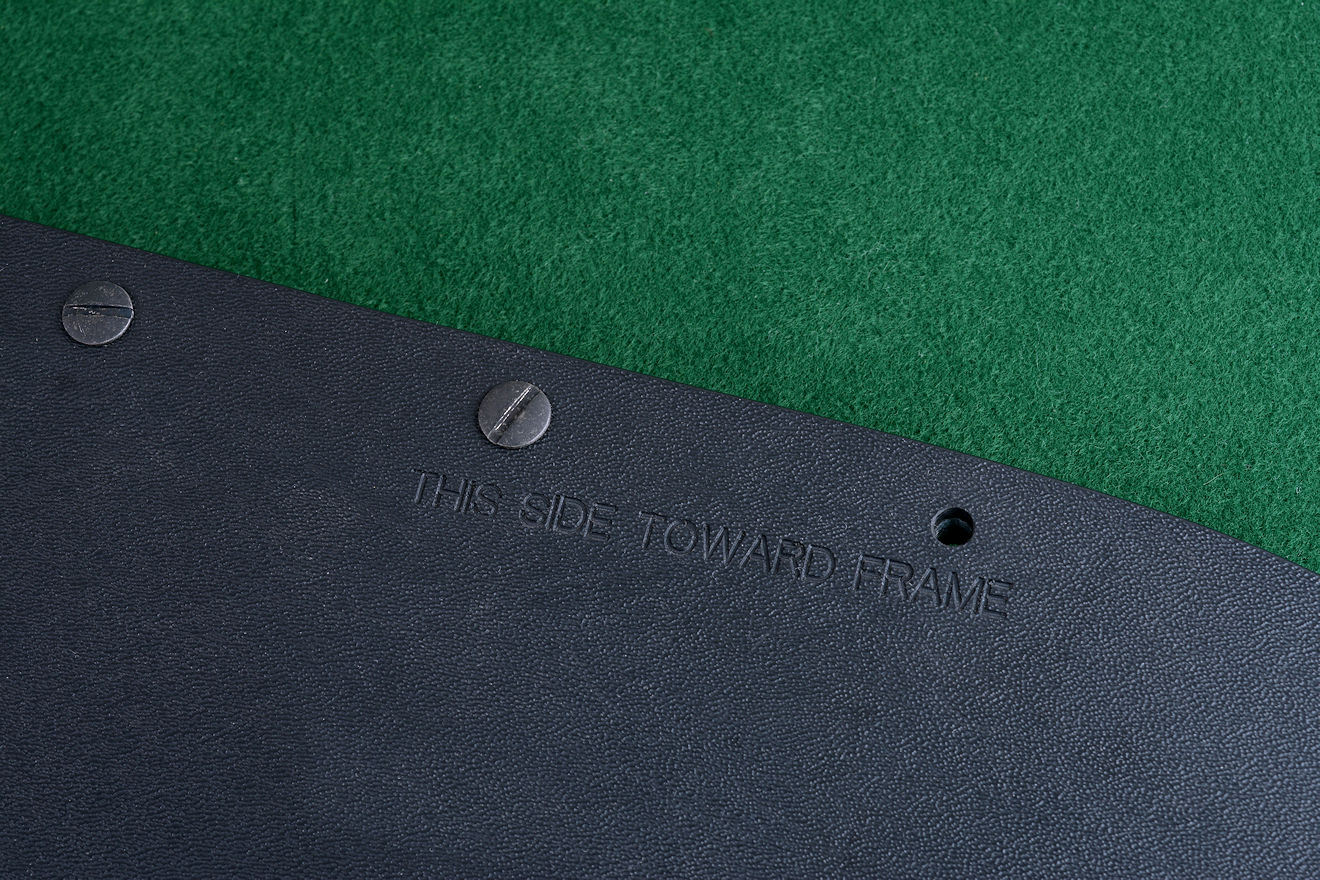
A great feature about this sheath and mounting arrangement are my modular sheath frame components. In the photo above, you can see that I've permanently engraved the text "This Side Toward Frame" on the kydex back. This will aid in locating and positioning the frame components that follow. Detailed video.
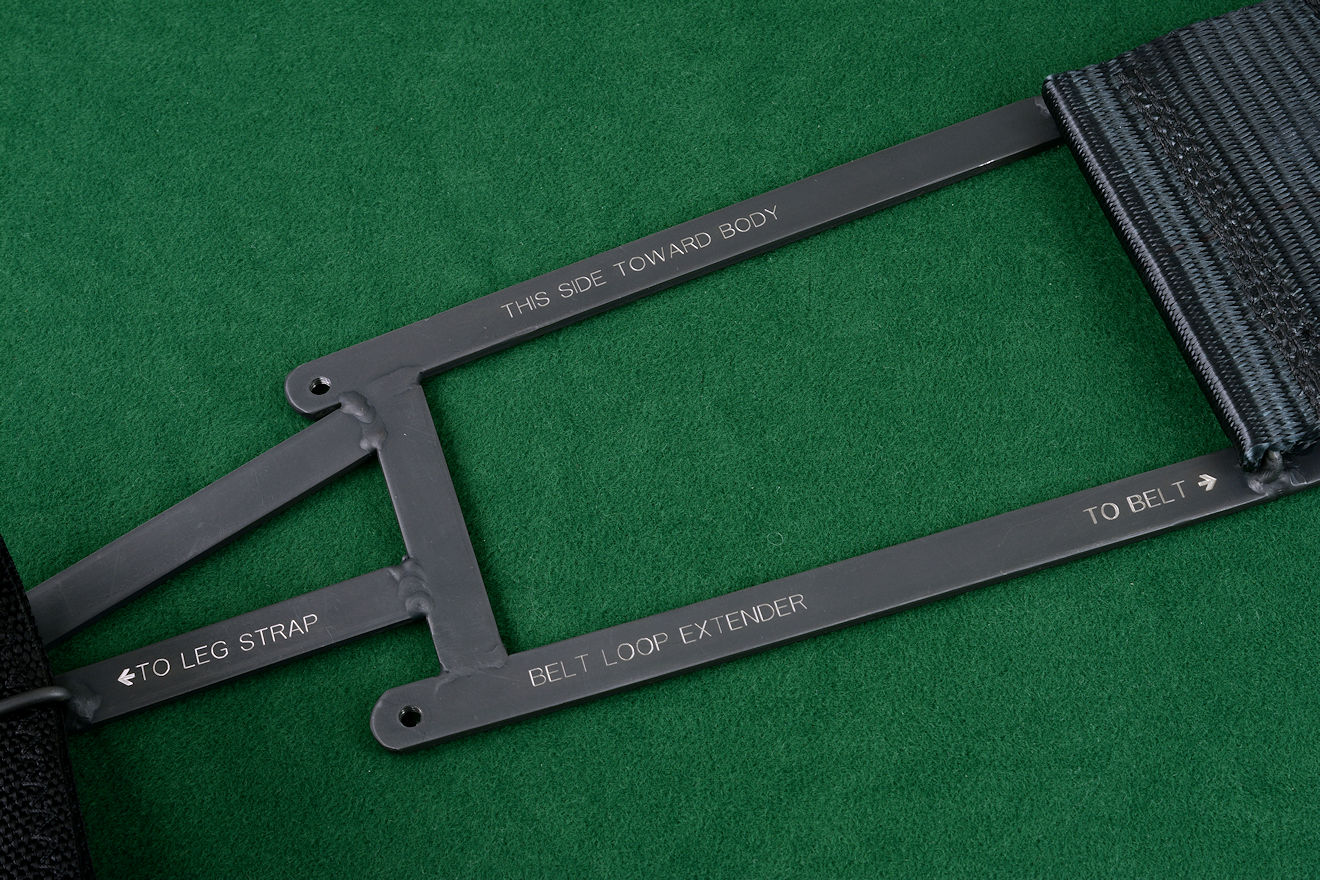
This is the first modular frame component, the belt loop extender. In the past, I've build my ultimate belt loop extender in an entire web form, in that it was built entirely in polyester or polyethylene webbing. On this large knife, I've moved to a stainless steel modular component system, which has some distinct advantages. The first one is that it allows immediate conversion of the knife and sheath wearing position without any tools. Simple thumbscrews are all that is necessary to make these changes. In the photo above, you can see the details of the frame. The frame is made of welded 304 stainless steel that has been blasted and oxide blackened for glare reduction. Into the frame, I've permanently engraved text detailing the purpose of the component (Belt Loop Extender) and arrows that point to each strap attachment position and purpose. Also identified is the side position (This Side Toward Body) to quickly orient the frame module. The frames are very tough and durable, made of the same stainless steel as stainless nuts, bolts, and fasteners. Detailed video.
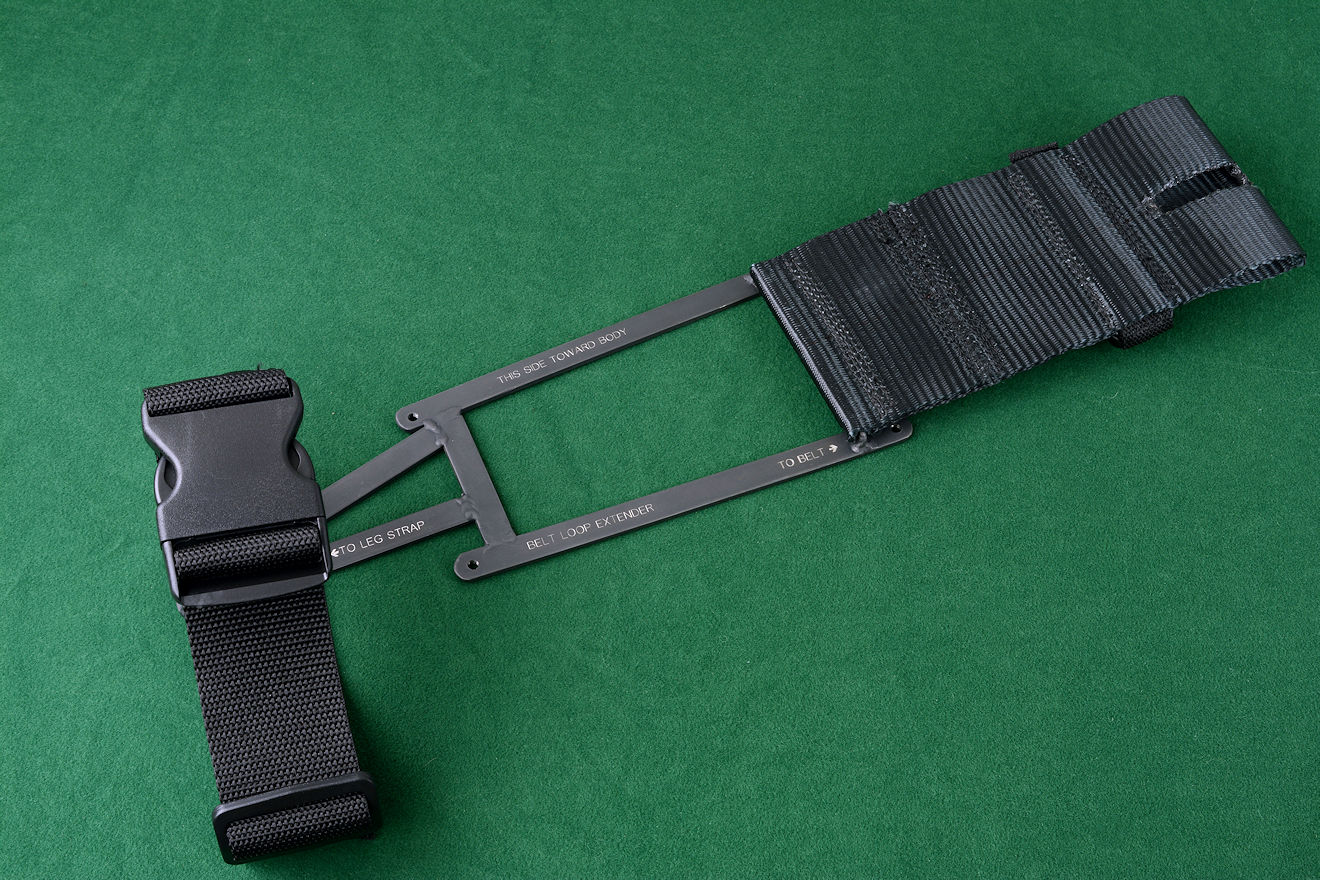
The belt loop extender allows a lower position of the sheath with the handle at the belt line and the tail of the sheath just above the knee. This particular arrangement of modules is for a right-handed client, so the belt loop extender is at the right hip. The top wide strap is made of 4" wide polyester webbing and is permanently attached to a welded 304 stainless steel loop in the frame. The lower strap is for the leg, and it's 2" wide polypropylene for comfort and low abrasion and chafing potential. The leg strap is fully adjustable and can immediately be removed by the side release buckle. All buckles are made of polyoxymethylene (POM) or acetal, and the 2" wide buckles have a breaking strength of 110 lbs. or 50 kilograms. All stitching is done with heavy polyester thread for ultraviolet sunlight resistance, color fastness, and non-absorption of water, so the possibility of mold, rot, or fungus is greatly reduced. This gear is all waterproof. Detailed video.
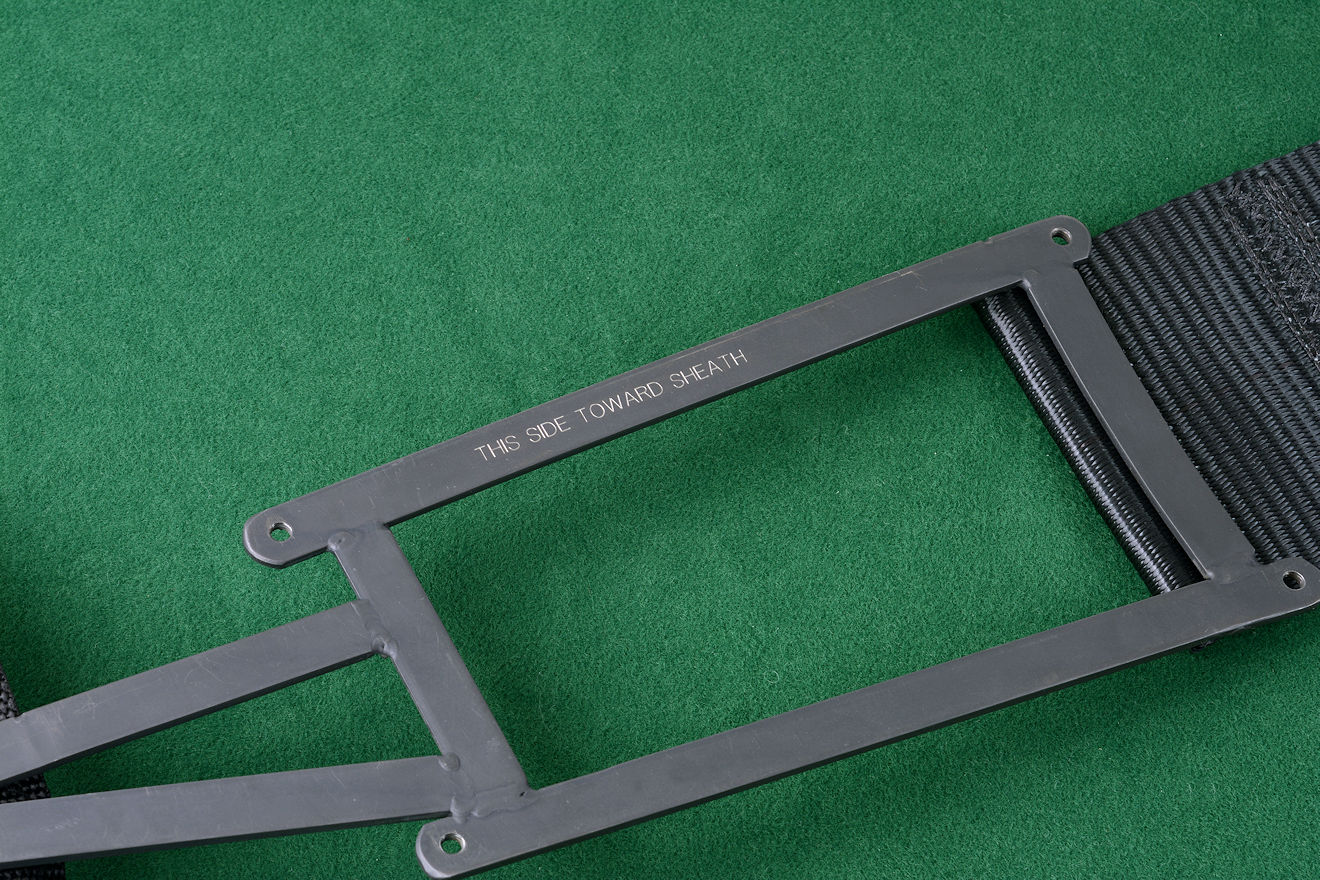
Above is a photo of the sheath-side of the modular frame. In the video, I make the mistake of incorrectly orienting the frame-to-sheath direction, and cannot start the thumbscrews. It's a lesson in the reason why I've engraved this important locating text on the frame and on the sheath back! Since these components are built individually for each knife sheath, orientation is critical or it won't work.
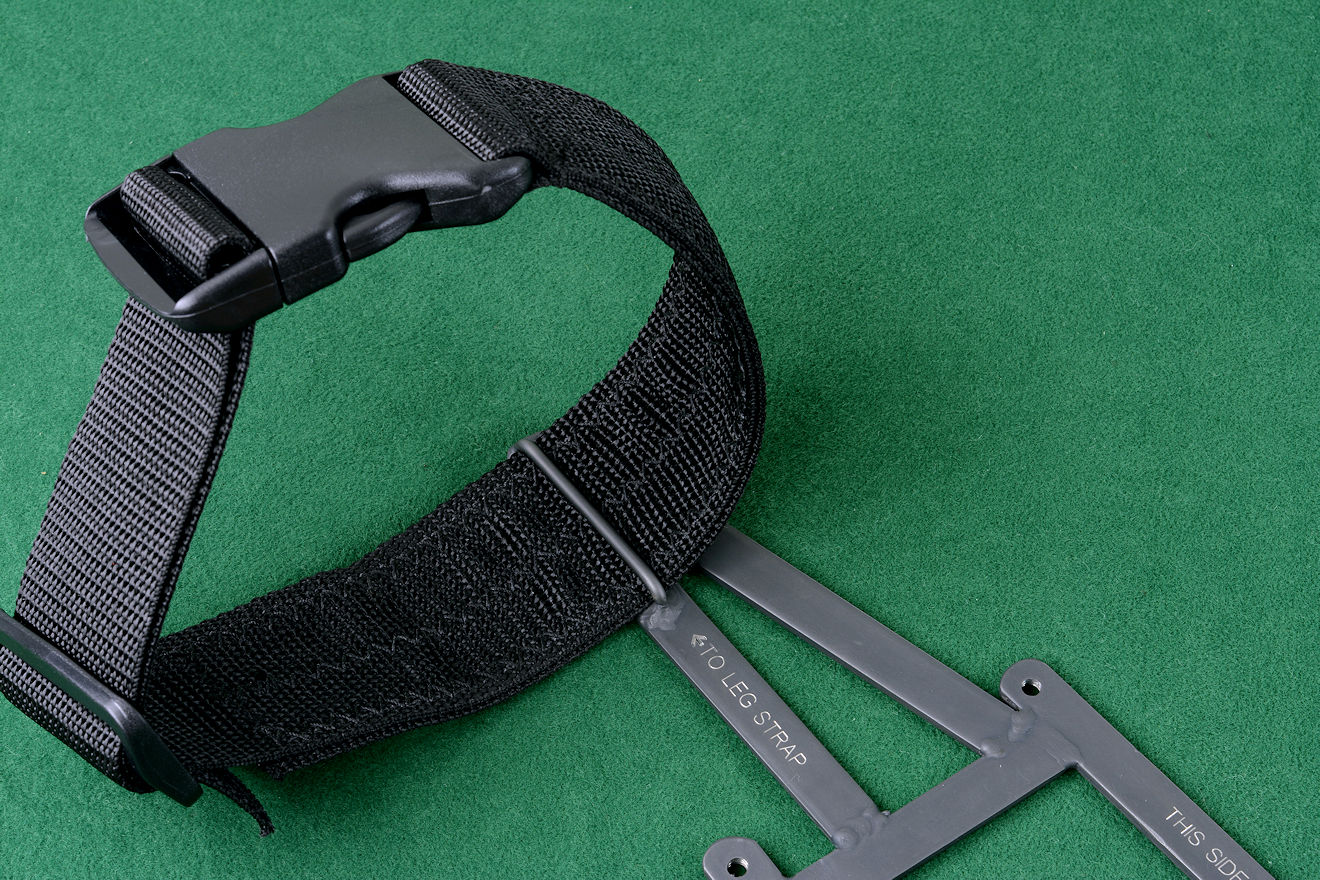
The frame loop (above) is welded stainless steel, and is very strong. To prevent the possibility of chafing and wear on the polyethylene webbing strap, any place in these modular frames that the webbing is attached is doubled in webbing thickness. You can see the doubled web in this photo, zigzag stitched with V138 polyester bonded thread for strength and durability. Notice also the tri-glide acetal component on the web; all of the webbing that accommodates the body for security is adjustable for an individual client's needs, size, and clothing or gear being worn.
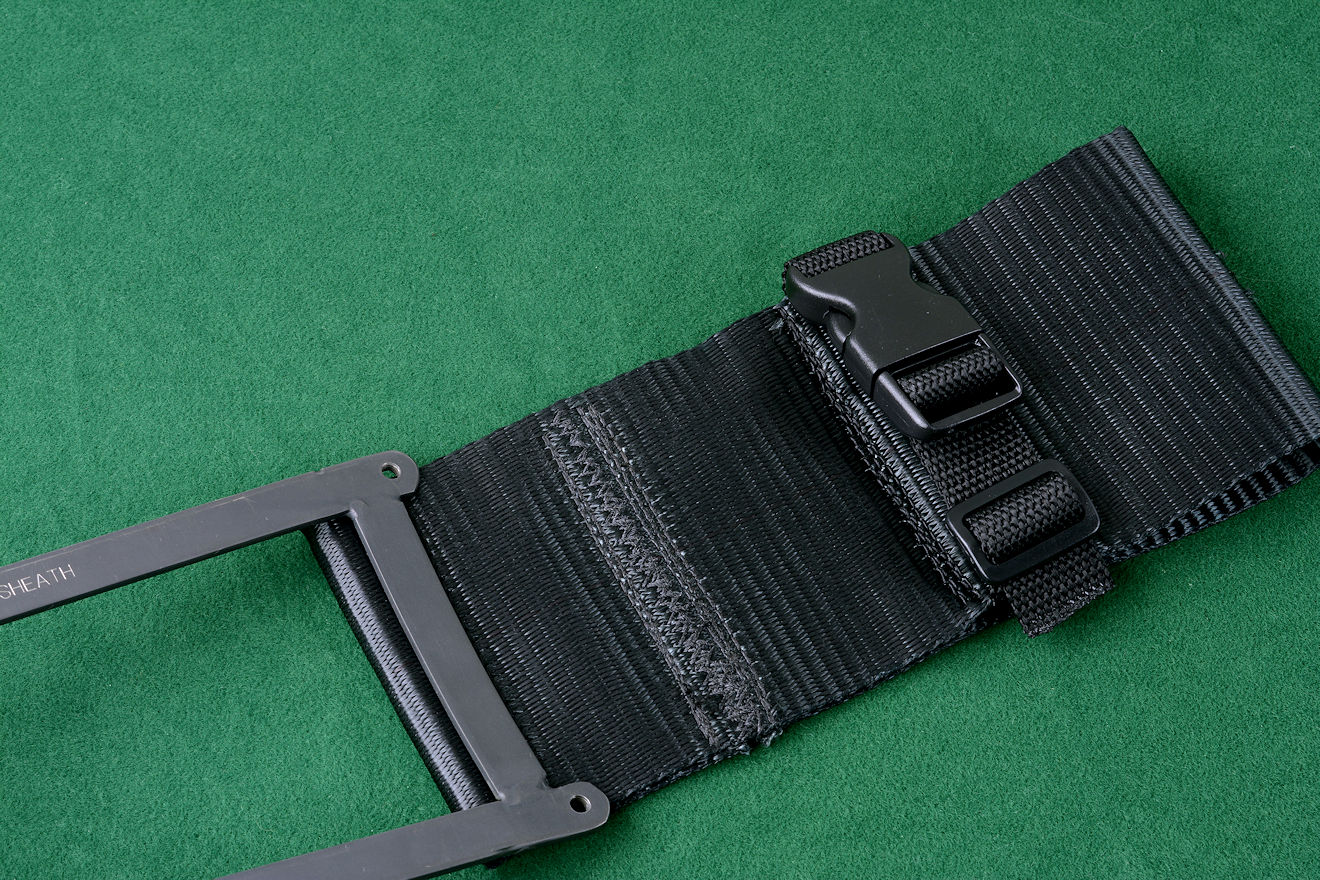
The above photo shows the 4" wide belt loop extender on the modular sheath frame. The extender is heavily stitched and also holds the anti-flop strap and buckle that stops the knife handle from moving and flopping out from the body in motion. See the Detailed video to understand this critical component and how it helps in wearing the extender.
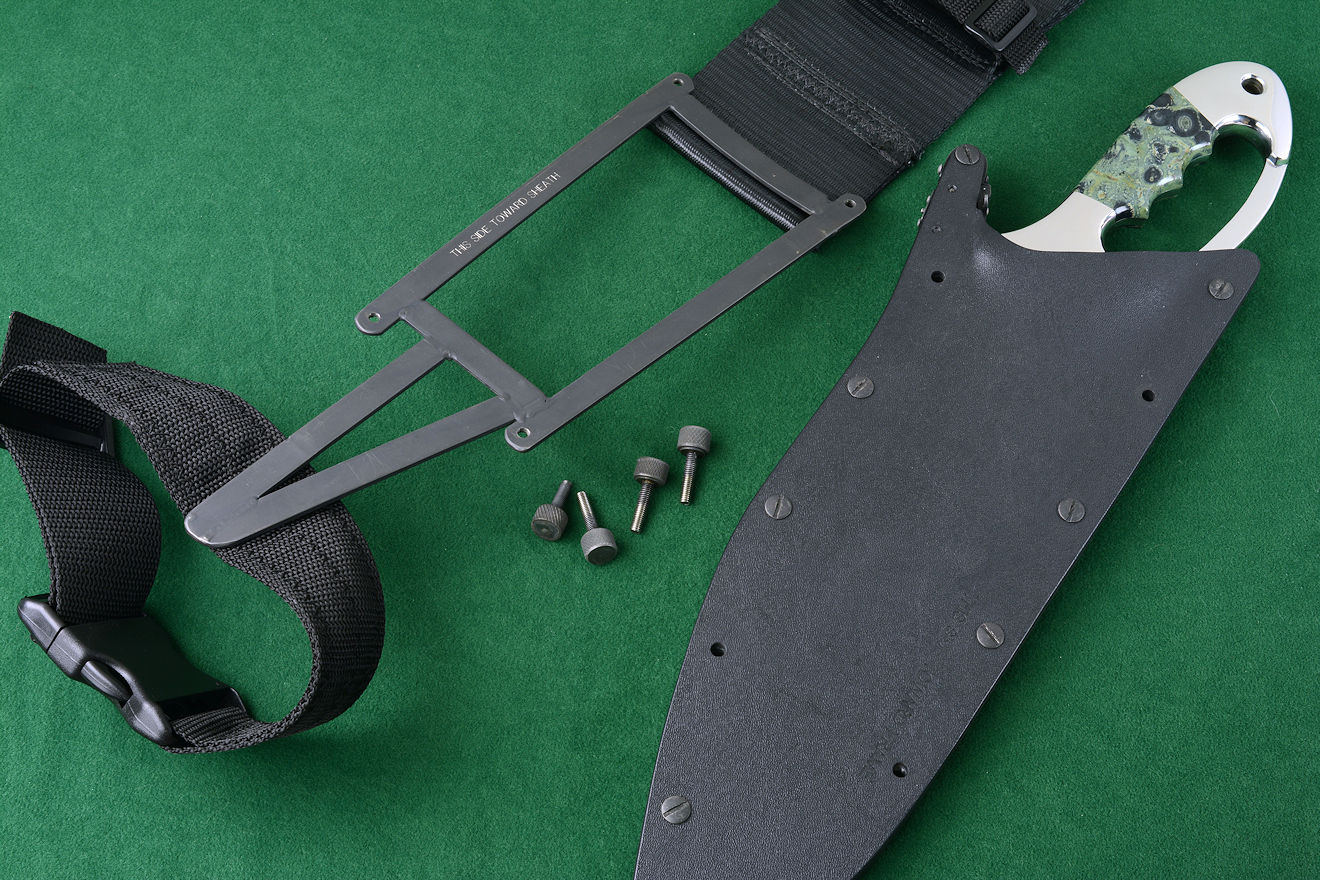
In this photo, the sheath is ready to mount to the modular component, the belt loop extender. This is done with four custom thumbscrews. The thumbscrews are all 304 stainless steel, knurled for easy handling, blasted and oxide black for non-reflectivity. To assemble this, the text "This Side Toward Sheath" and "This Side Toward Frame" must be obeyed. Detailed video.
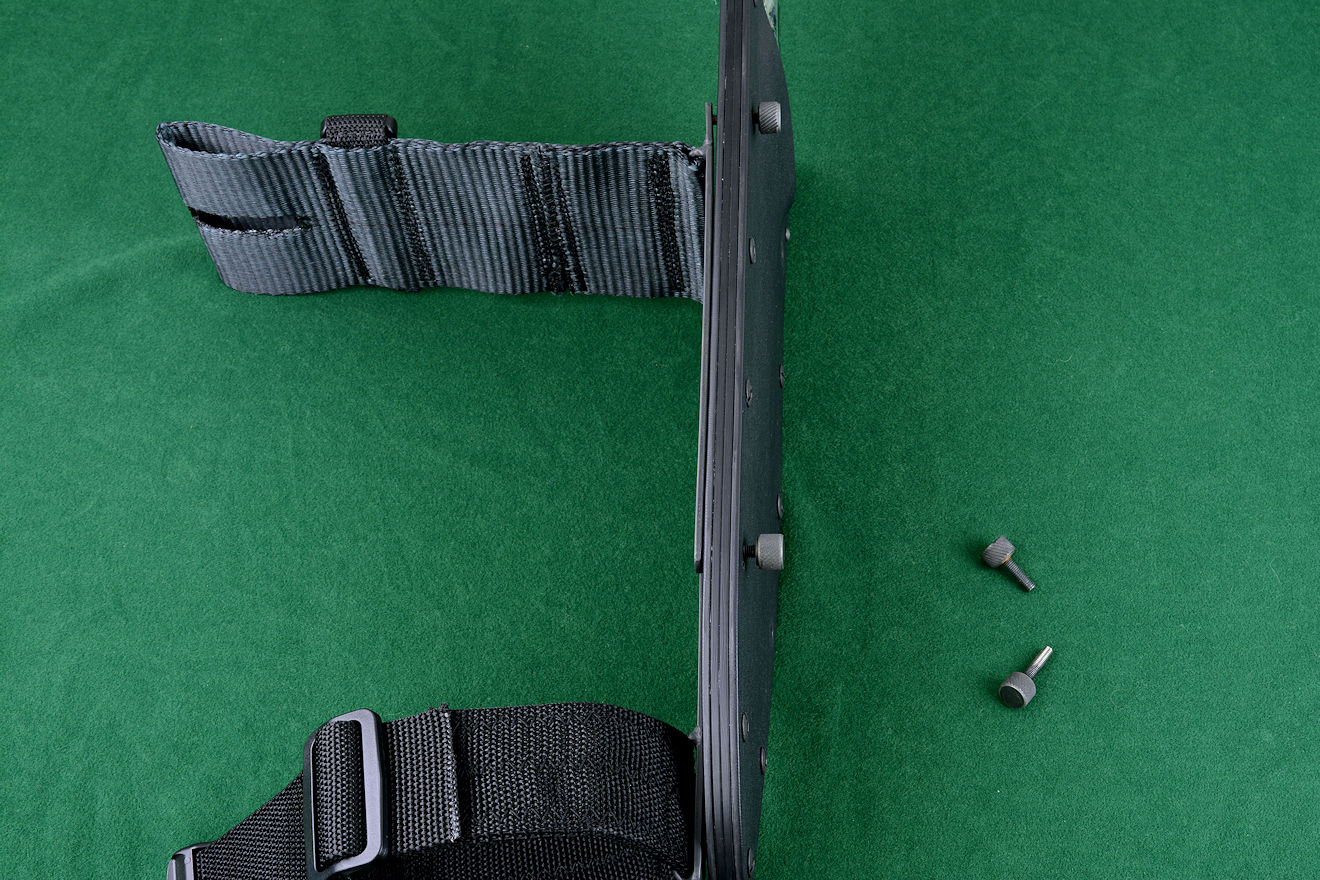
In the above photo, the modular frame component is being mounted to the sheath body. The thumbscrews are started carefully, to avoid cross-threading, by hand. Once all screws are started, they can be hand-tightened. No tools are needed and they don't need to be super-tight, just snugged up and they will stay put. The frame only fits one location on the sheath, and all frame modules fit in that same place. Two sizes of thumbscrews are provided, long and short, and as long as the threads of the thumbscrew reach completely through the frame, they will stay. This is a very fast and easy change of the wear accessories, and no tools are needed.
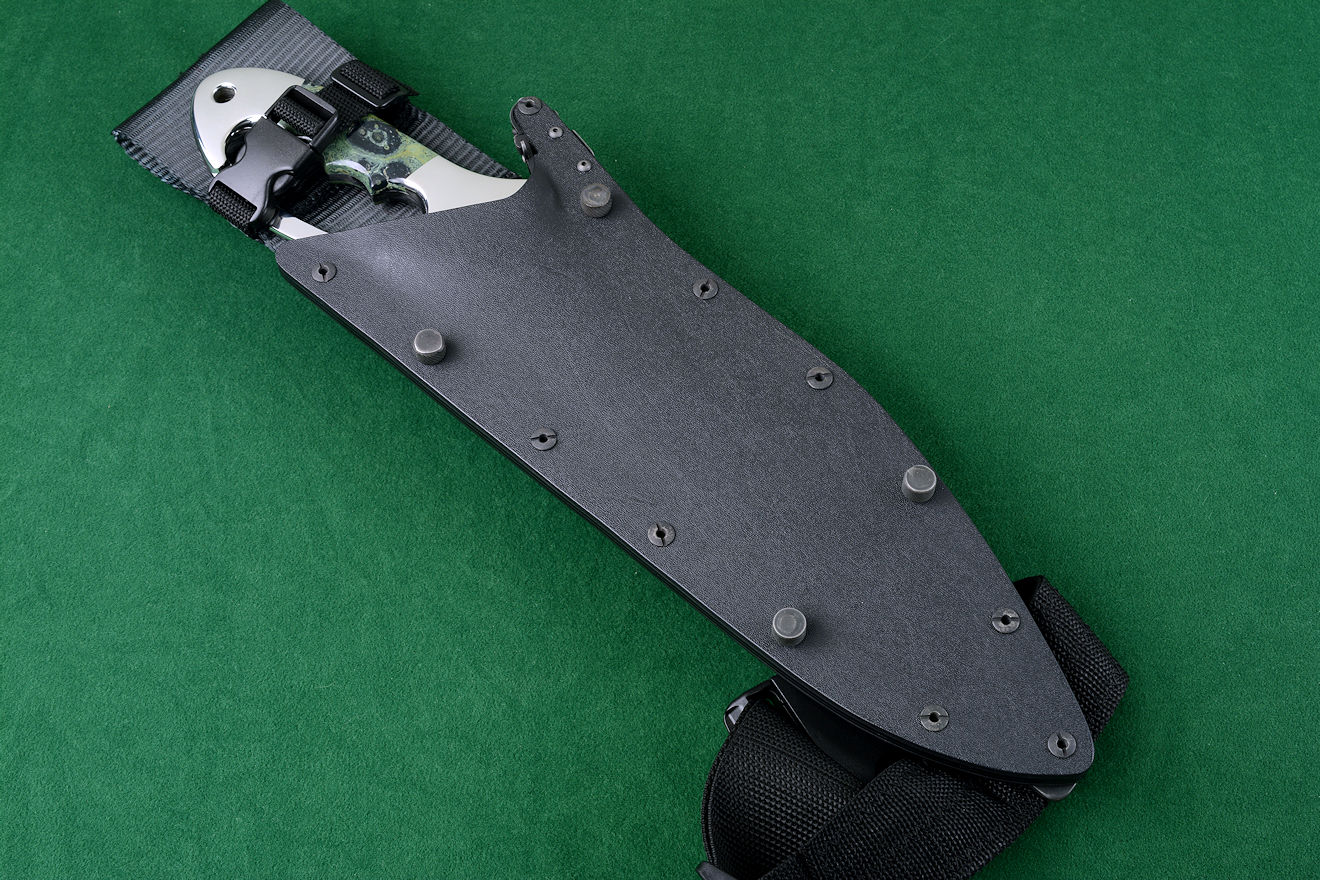
In this photo, the belt loop extender sheath module is assembled. You can see the positions of the four thumb screws in the sheath front. Also shown is the correct placement of the anti-flop strap to hold the knife handle from flopping away from the body. Detailed video.
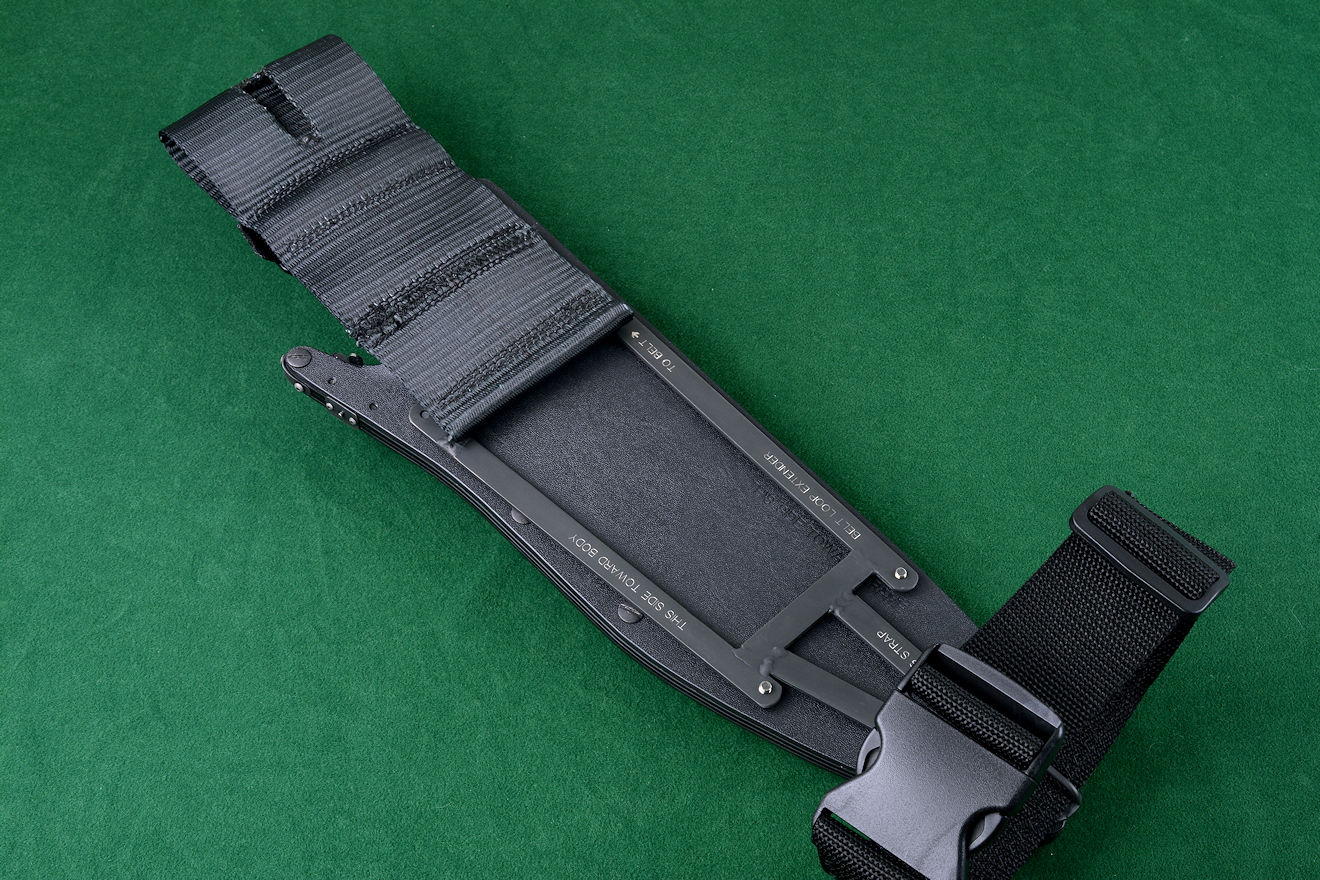
Above is the back side of the sheath with the modular belt loop extender attached. In the wide loop is the central cutout that allows a pants belt loop to be positioned in the belt line with the extender. This will lock the upper strap to the pants. It's a bit challenging to mount this with the pants loop (your pants may fall down while you string the belt through!) but it's extra security if needed. All cuts, trims, and ends of all the webbing are heat-fused so that the webbing component won't unravel.
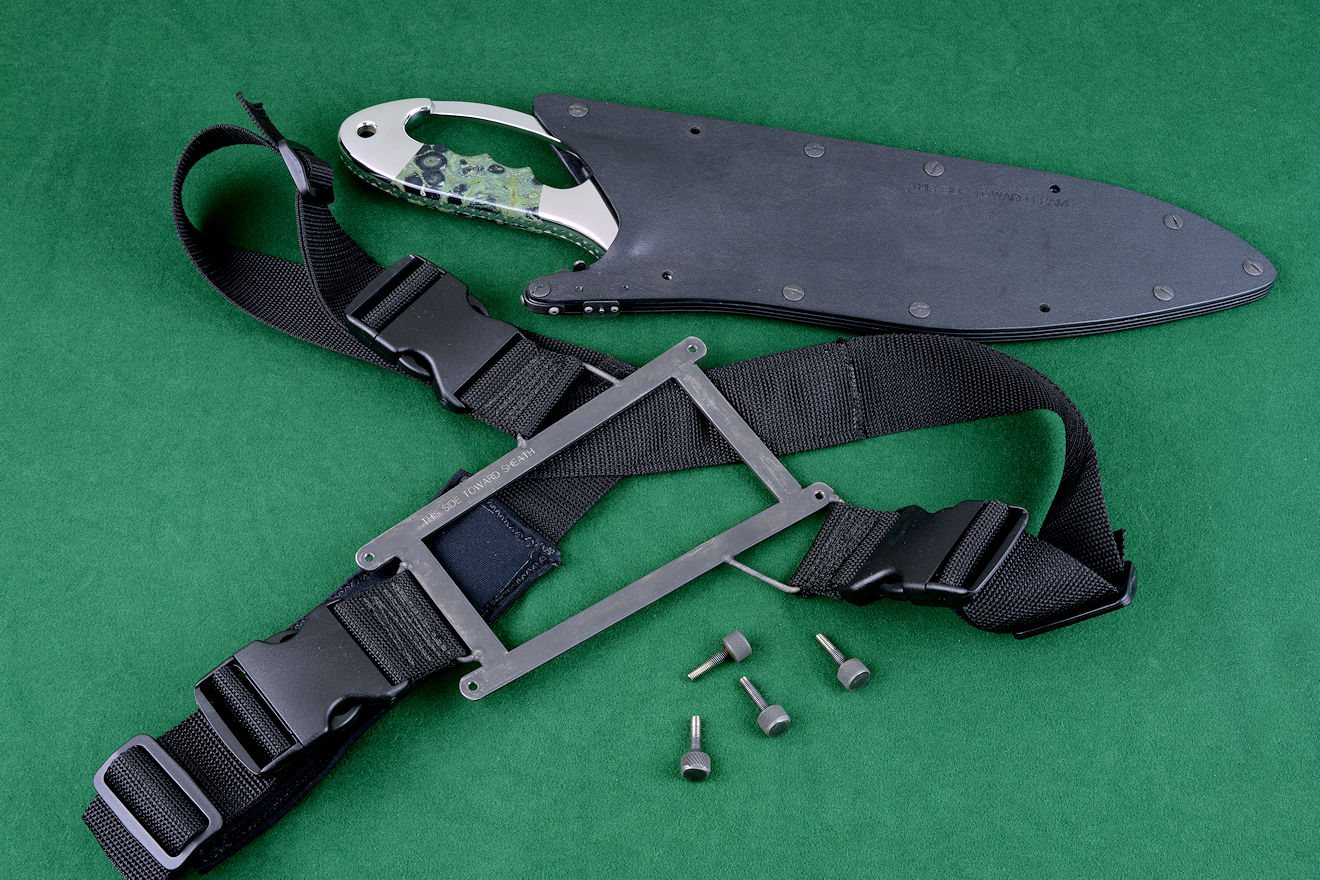
The next module is the sternum harness. The sternum harness allows wear of the knife handle down and blade point up over the left side clavicle. The mass of the blade and sheath are across the sternum, with the right hand unlocking the knife from the sheath and pulling down and to the right, withdrawing the blade. On smaller knives in the past, I've made these completely from webbing, which was adequate, but took some time and effort to mount to the knife sheath. In this modular frame system, the module already has the straps mounted and all that is needed is to screw the sheath to the frame with the thumbscrews and don the webbing and sheath. Detailed video.
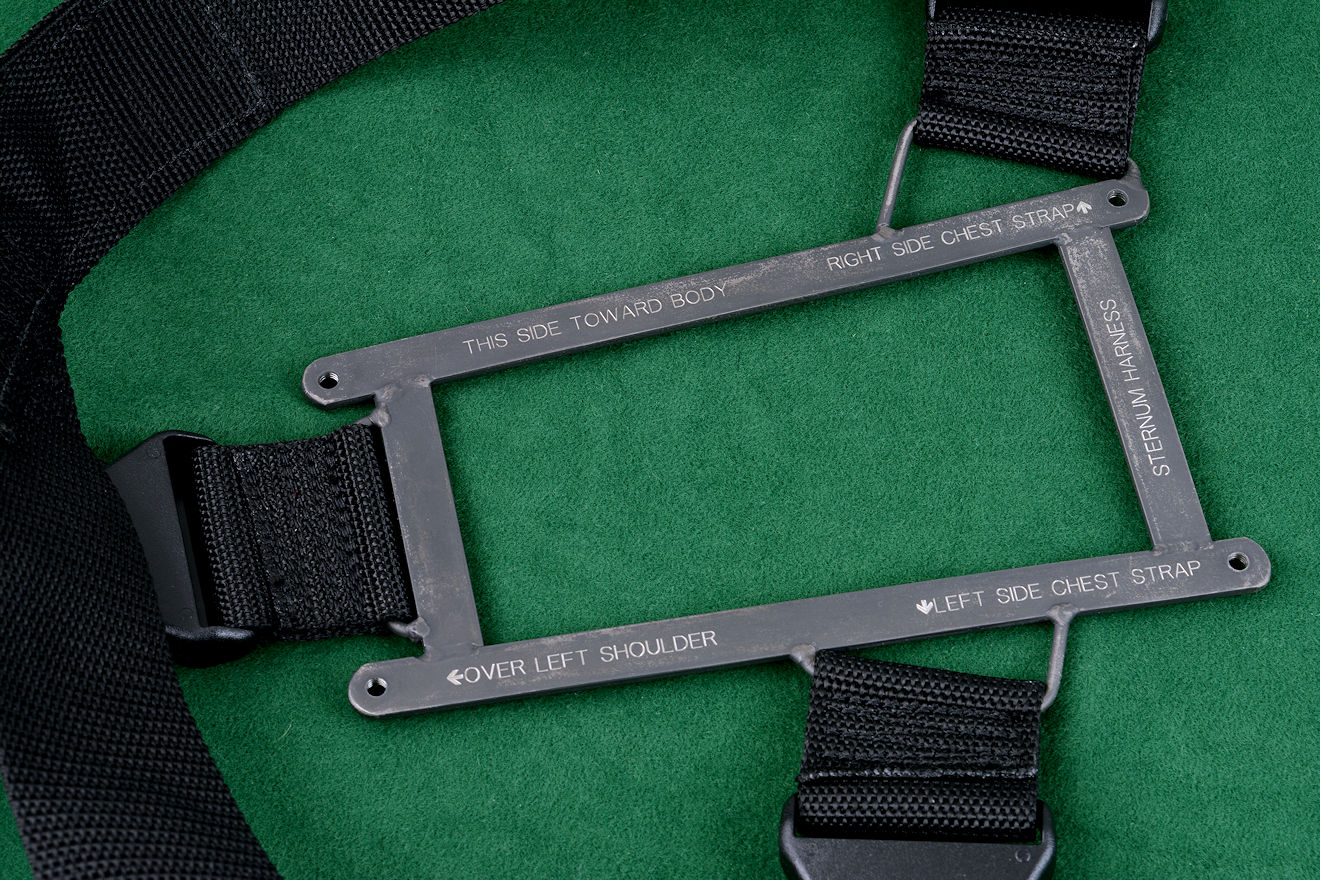
Above is the detail of the sternum harness module frame. Engraved are the module (Sternum Harness), the side (This Side Toward Body) and the arrows indicating the strap positions: (Over Left Shoulder), (Right Side Chest Strap), and (Left Side Chest Strap). Note the double-layered heavily stitched 2" wide webbing at the attachment points for durability.
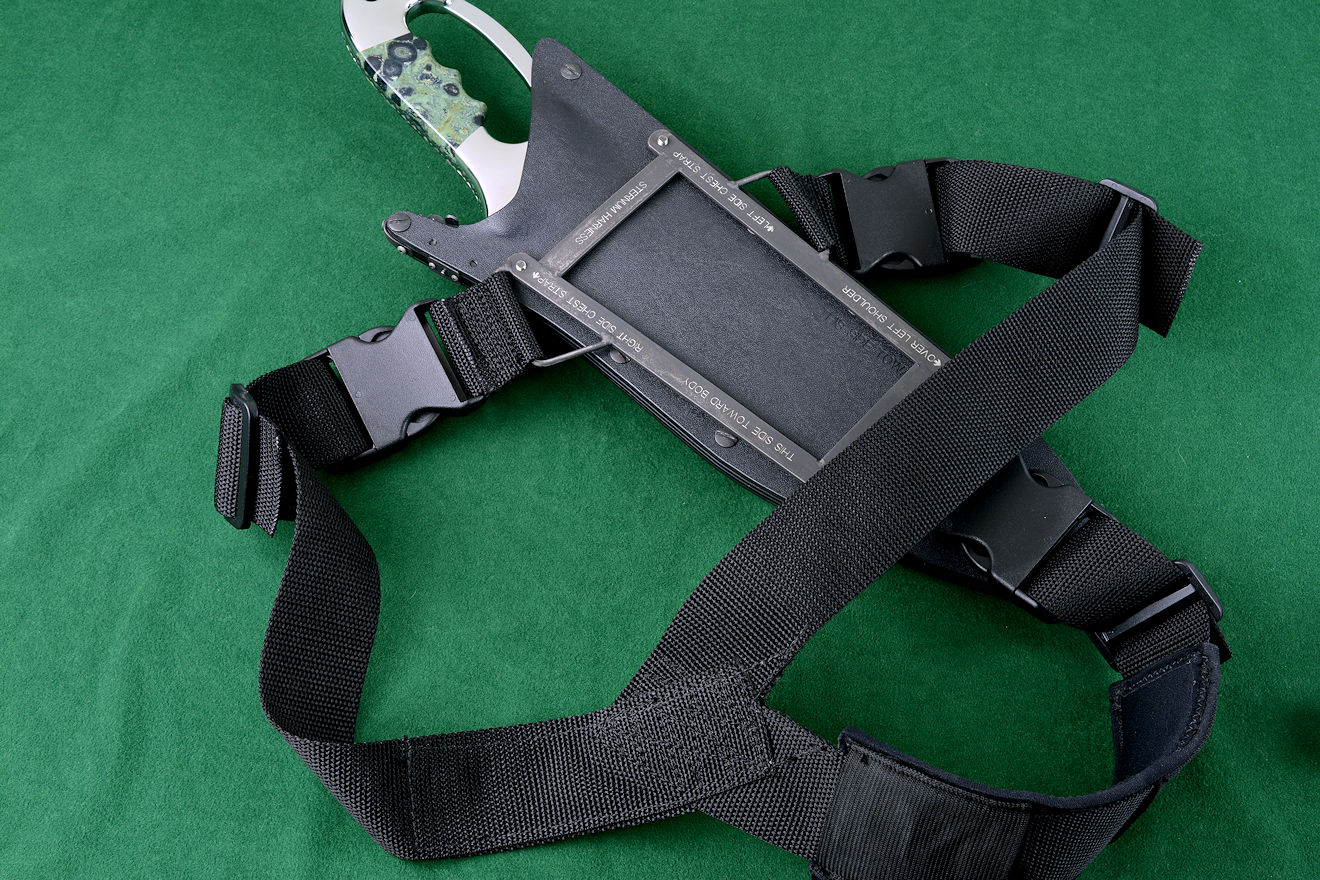
Above is the sternum harness module attached. This module has three point suspension and specific angles of the joined 2" polypropylene straps at the back result in a comfortable wear. The engraved text of the strap locations on the frame help in donning the gear. Detailed video.
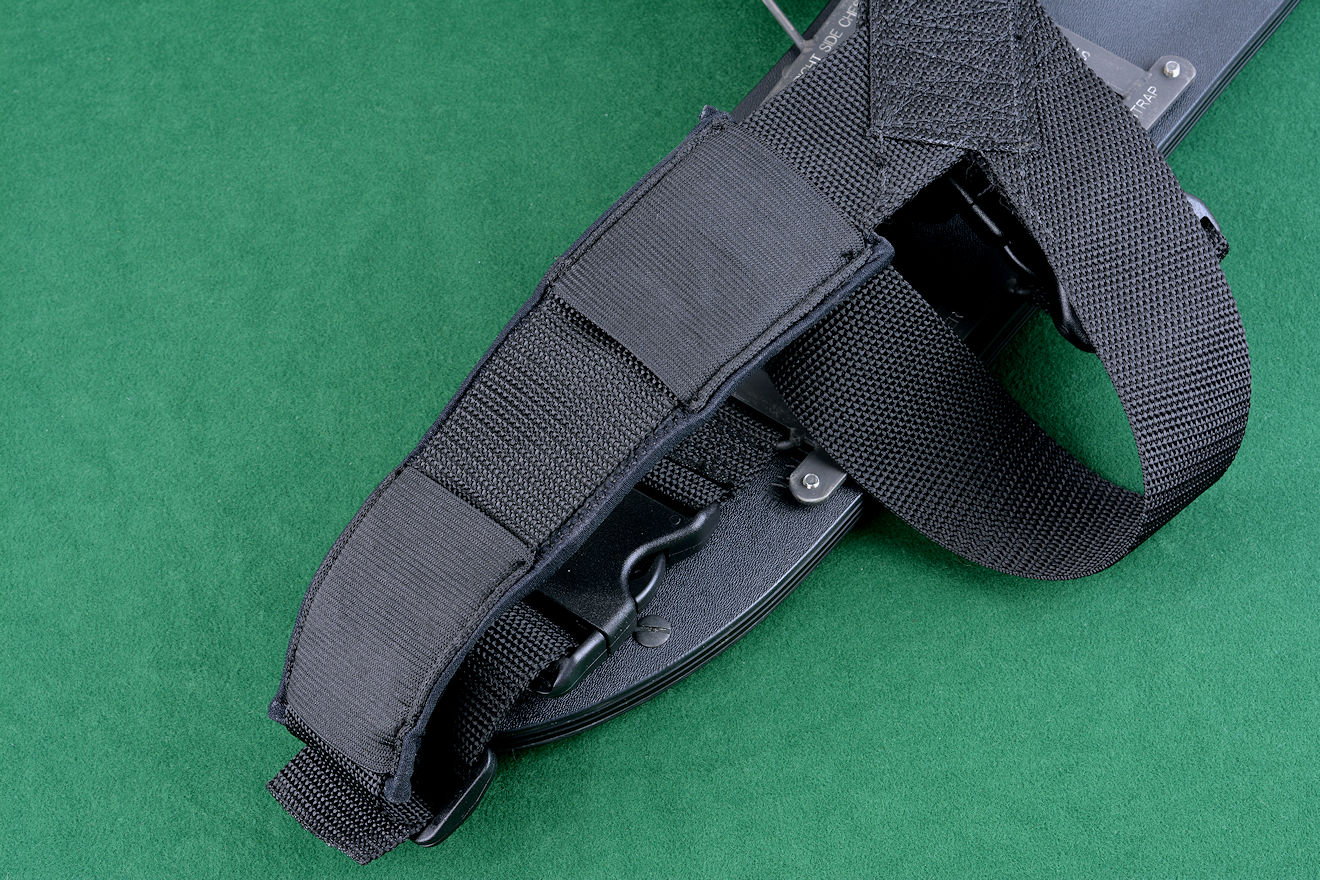
This photo shows the padding included in the strap module. For any strap that goes over the shoulder, I've made, thick foam neoprene pads that slide onto the 2" wide webbing and are held tightly in place with 3" wide elastic straps. The pads are made of wetsuit neoprene, one of the thickest available at 10mm. The edges are sealed and they are stitched with polyester for fungus and mildew resistance and durability. They add a bit of extra abrasion resistance, and are soft and comfortable. Because they only are mounted on shoulder straps, they make it easy to quickly determine which strap goes over the shoulder when donning the gear in a hurry. Detailed video.
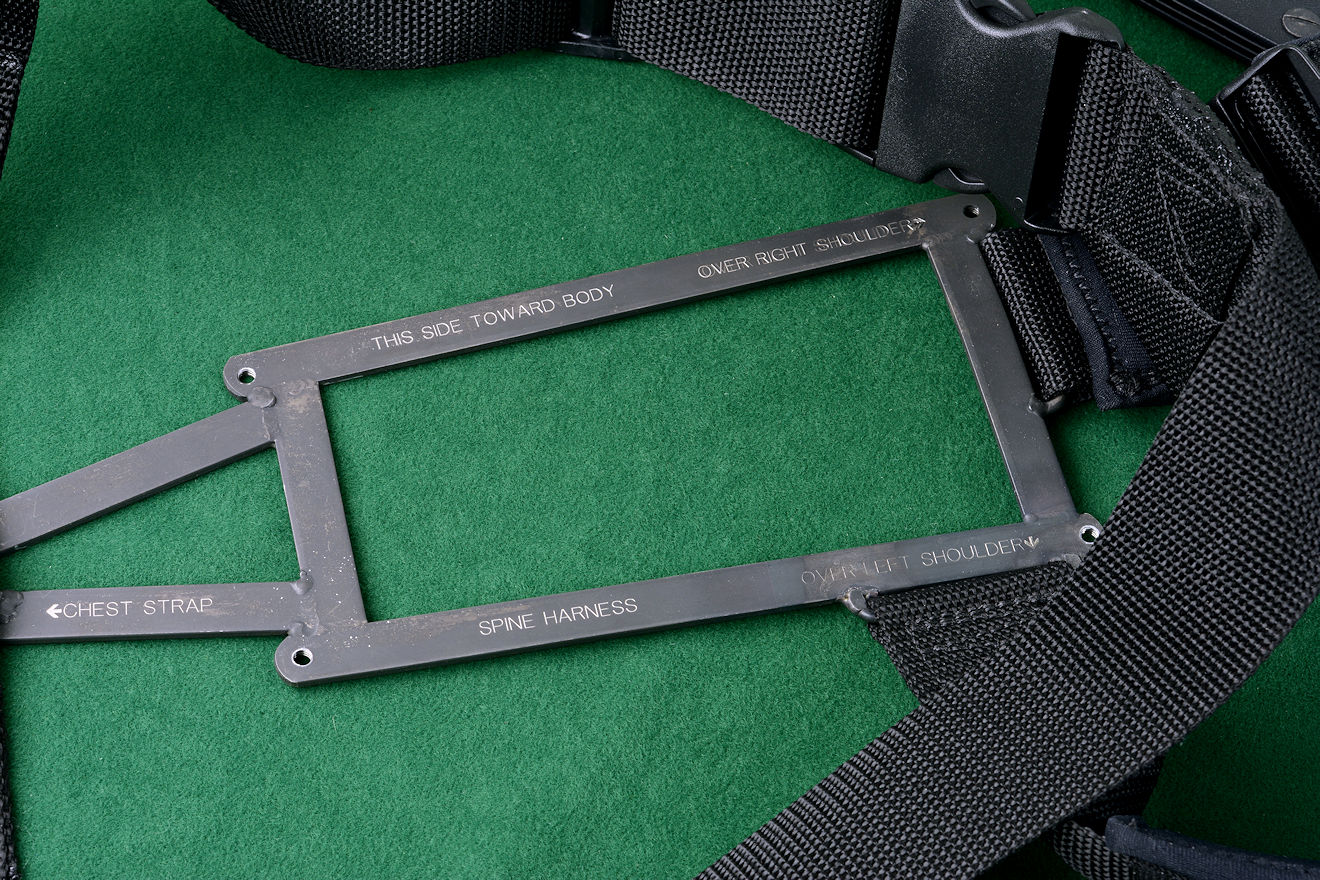
Above is the third component of the modular frame system for the sheath, the spine harness. This is a harness that allows the knife to be worn over the spine, with the handle between the neck and the right shoulder. This allows the user to reach over his shoulder with his right hand, grab the knife handle and unlock it from the sheath, and withdraw the knife over the shoulder. It requires a three point suspension for the chest strap, the strap over the left shoulder, and the strap over the right shoulder. Detailed video.
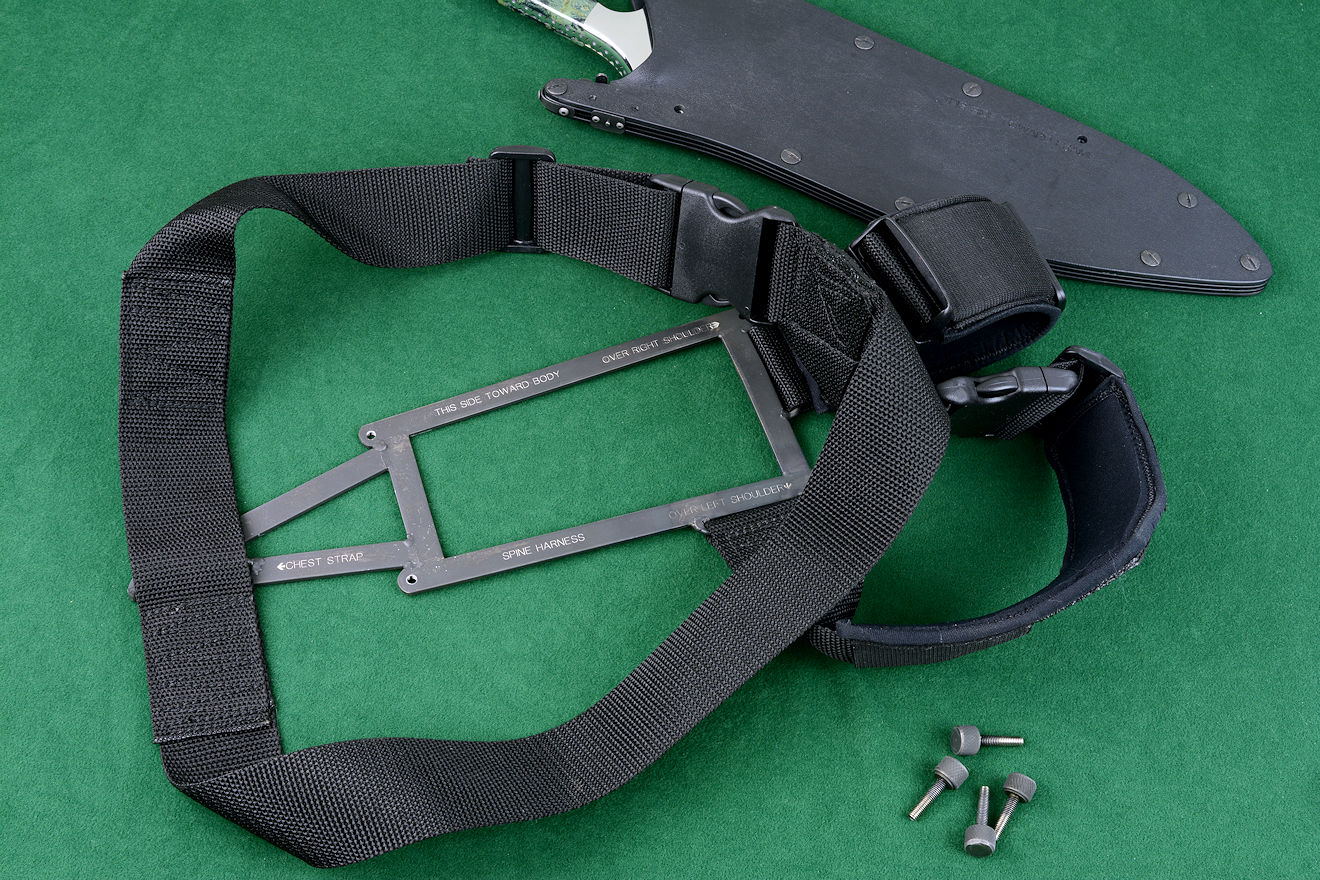
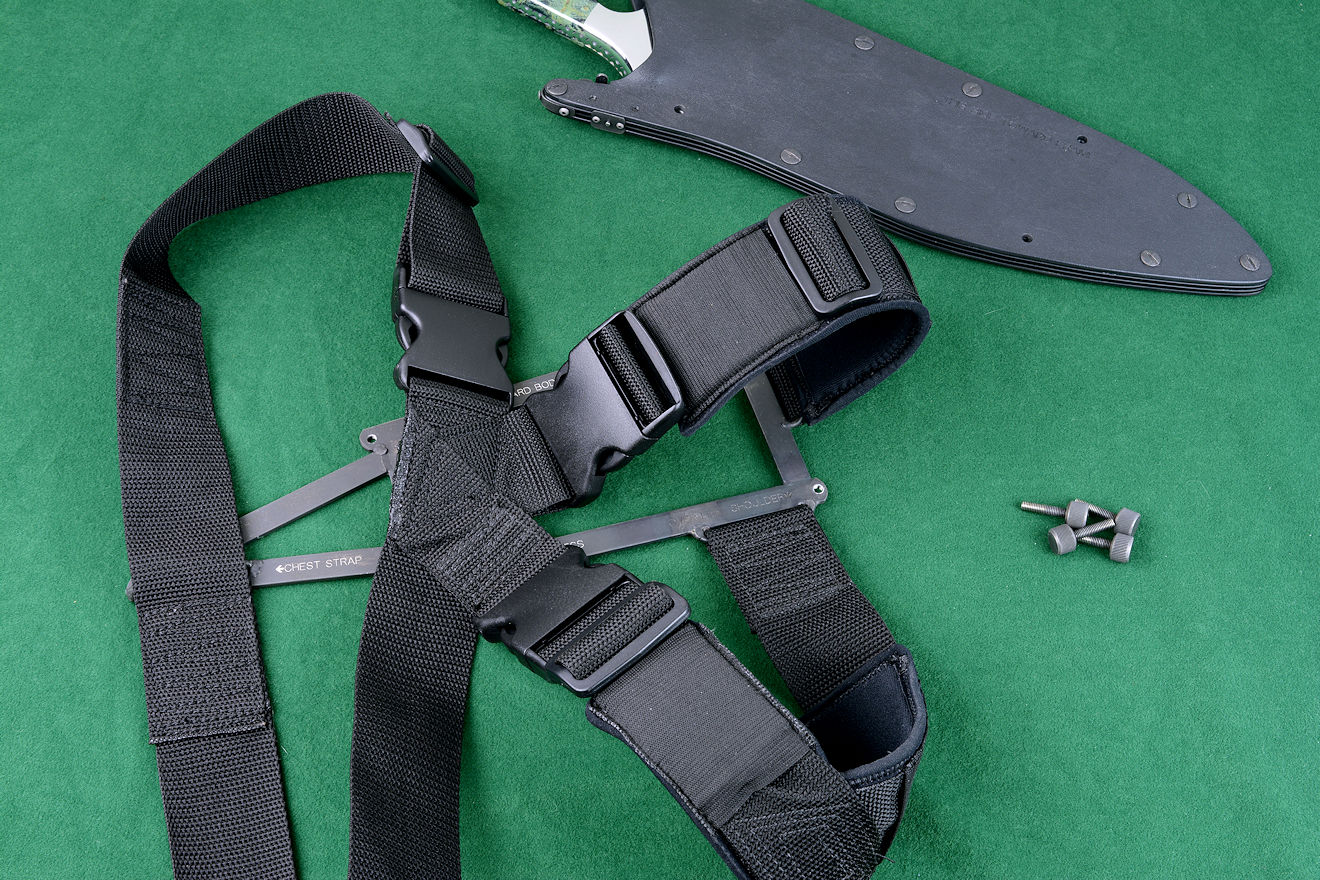
Above is the webbing arrangement of the spine harness module. Notice that four webs come together and this four point suspension is joined at the sternum. Each webbing strap is adjustable with tri-glides for staying the free ends of the web, and each critical web joint is buckled with 2" side release buckles. These allow very speedy and controlled donning and doffing of the gear.
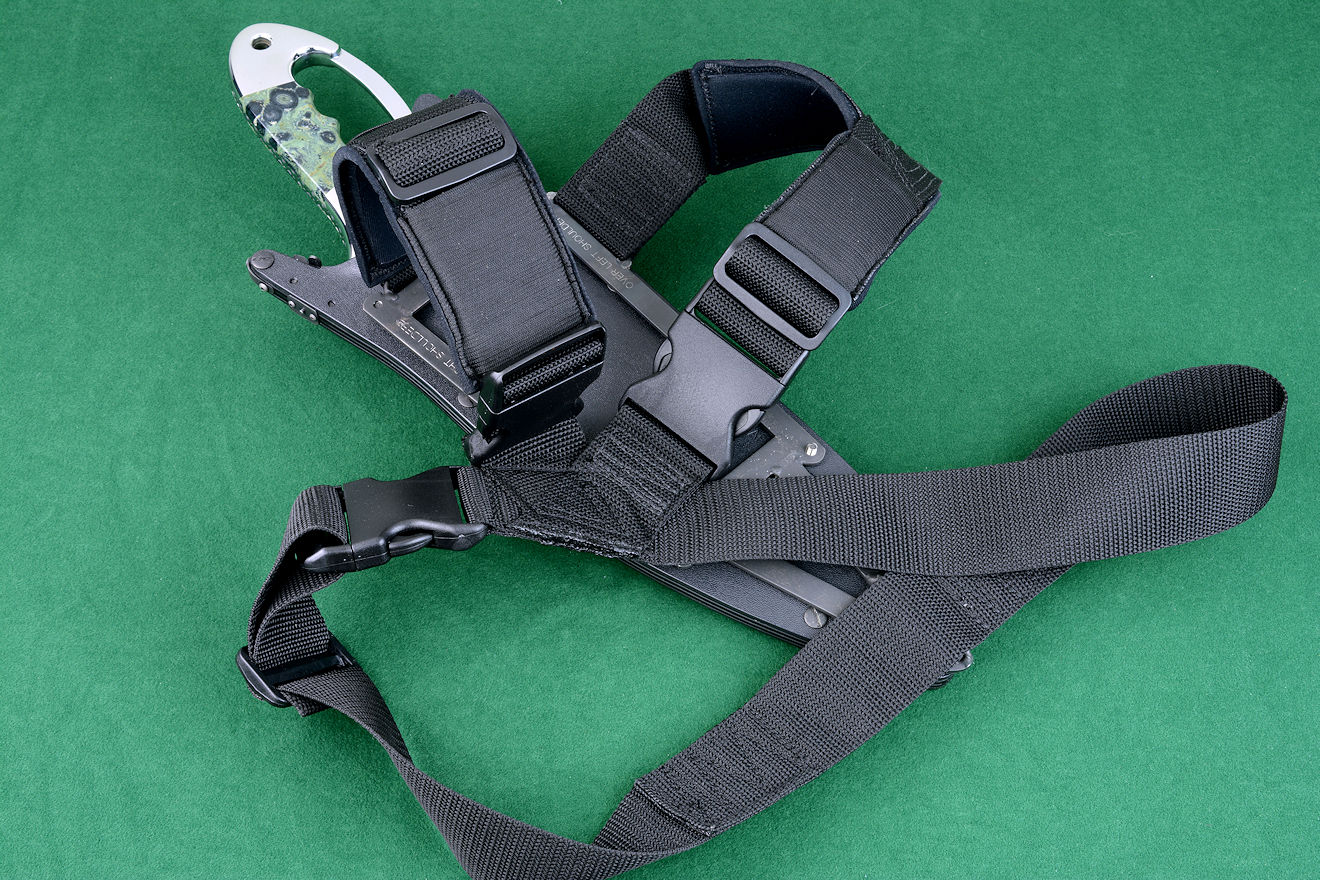
The spine harness module is assembled to the sheath. The straps are shown buckled for illustration of positions of the straps. See the video for details; though the straps look complicated, after two or three donnings of the system, it's easy and fast. Detailed video.
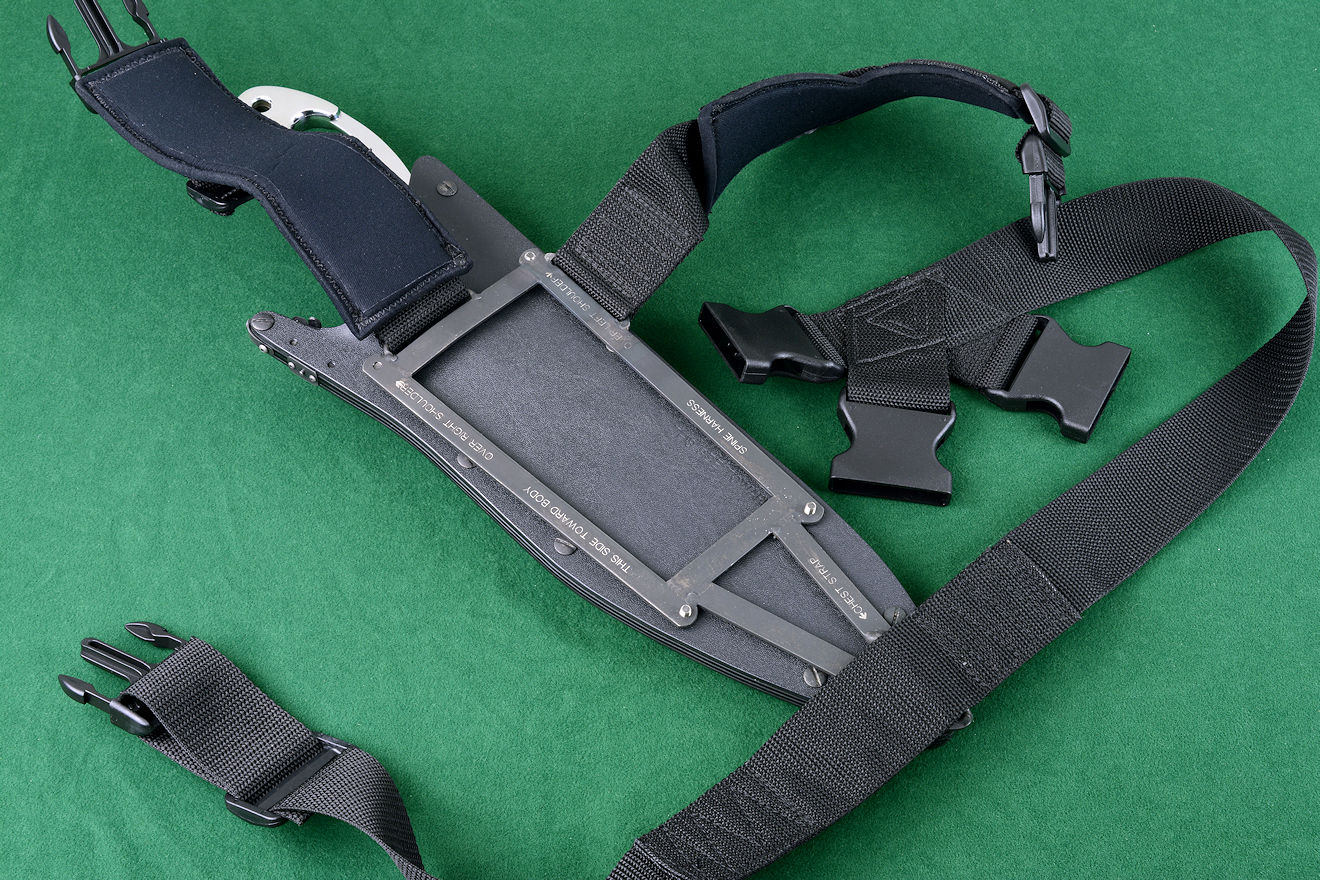
The spine harness is ready to don. Buckles are released, and by locating the padded straps, it's easy to see how the gear is mounted over the shoulders. For a right-handed person, I find it easiest to string my left arm through the gear first and secure additional buckles with the right hand. Detailed video.
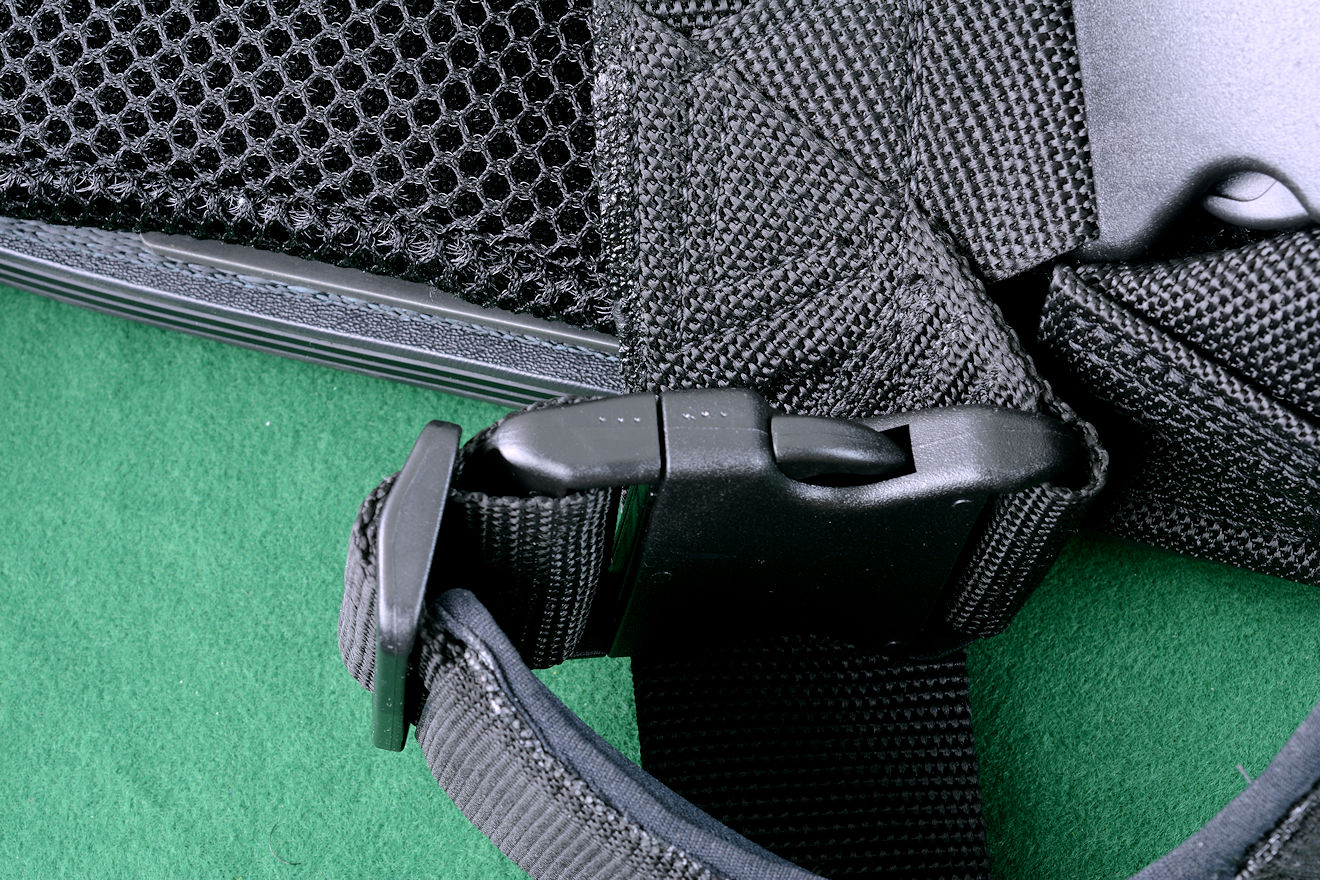
It can be confusing to match multiple buckles on this gear, so I've devised a very simple plan to do so. On the modules that have multiple buckles, I've punch-marked a series of indentations on the side of the buckles. They have one, two, or three punch marks, and the buckles are oriented to match in direction at those punch marks. Once familiar with wearing this system, these are not usually necessary, but in learning how to don the gear, they are a great help. Only the right buckle in the right position will match the marks.
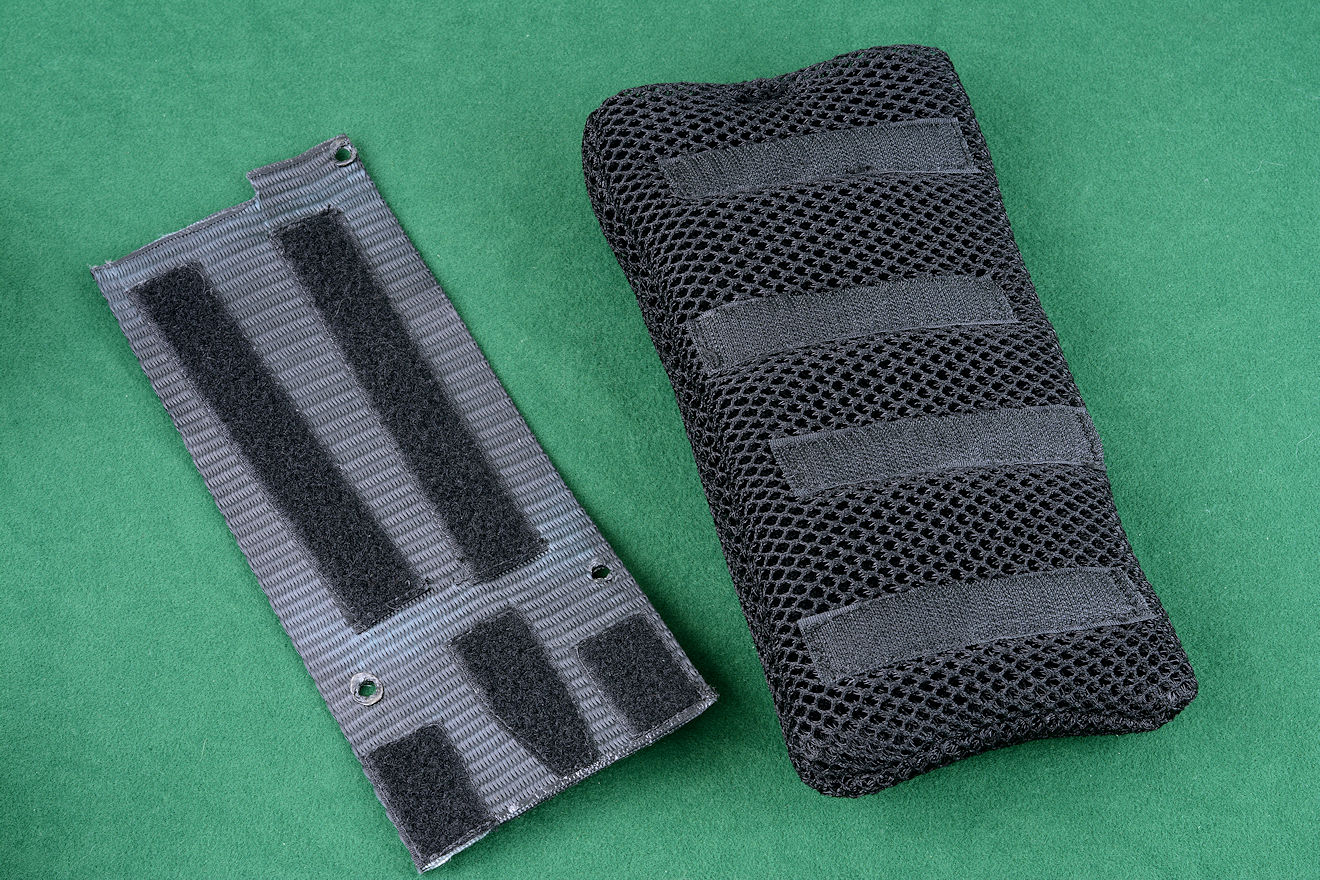
In order to improve wear comfort for my client, I've incorporated a mesh pad system that fits all the module arrangements. This universal and simple pad has some sophisticated properties. The pad is actually a double-thickness arrangement of expanded mesh that is typically worn between body armor plates and clothing, in IOTV and MOLLE gear in the United States Army tactical vest, and in law enforcement gear. It does not compress but slightly, and always returns to its shape, and is 5/16" thick, with 1/4" inch of air space between each layer. Since there are two layers, this allows 1/2" (13 mm) of air space between the sheath back and the body. This makes wearing a big knife sheath comfortable and allows breathable air to keep the wearer cooler while wearing the large knife. It's held in place by an anchor pad made of 4" wide polyester stitched with pads of hook and loop (Velcro®) loop component. This anchor pad is mounted between the modular stainless steel frame and the sheath when screwing on the module. The "hook" component is stitched to the ventilated expanded mesh, and is held in place between the module and the body. Detailed video.
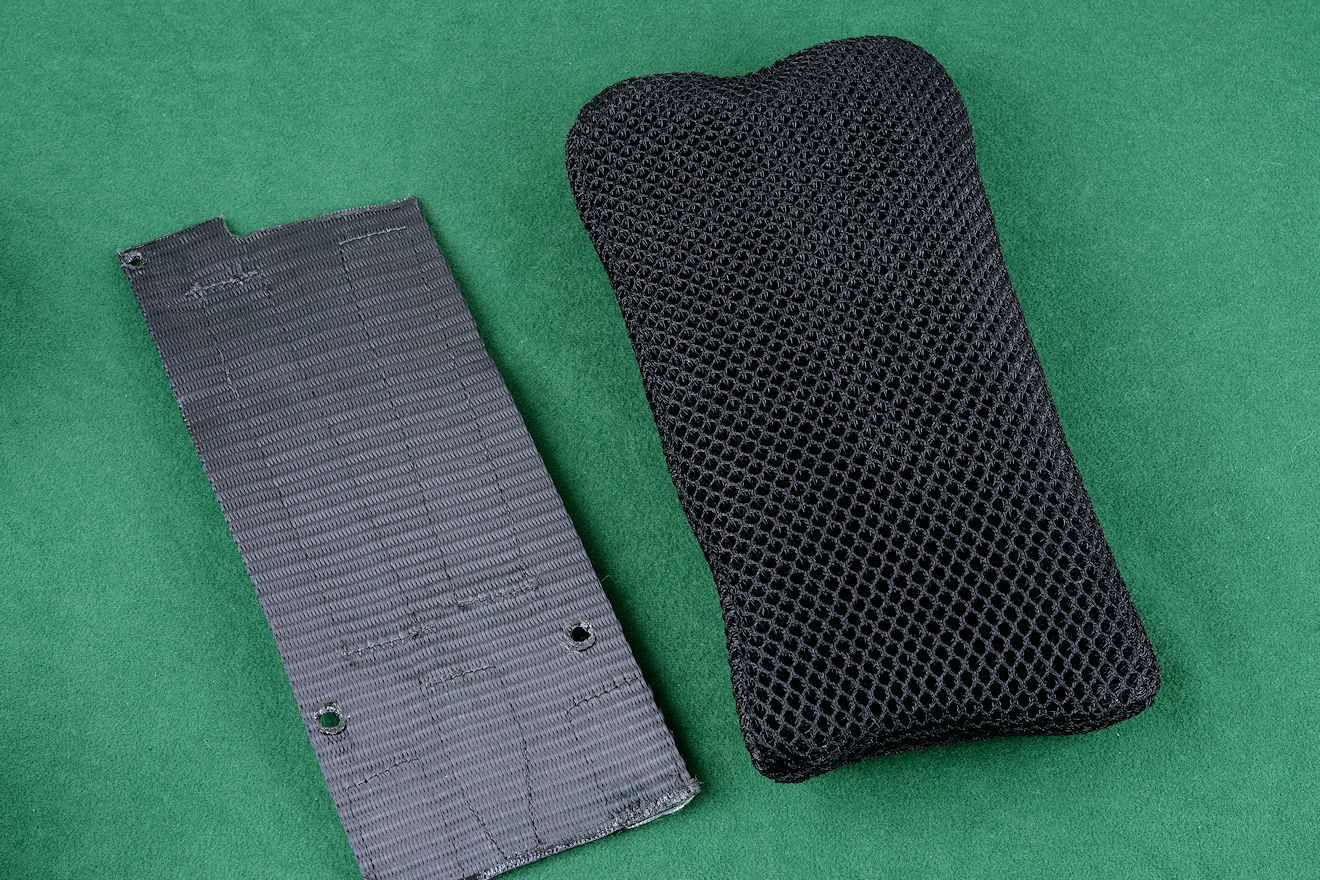
This is the other side of the mesh pad and anchor. The pad is thick and durable, the anchor is stitched with the loop strips and the edges sealed to prevent fraying. The ventilated pad is 5" by 10" and the entire assembly weighs less than 3 oz.
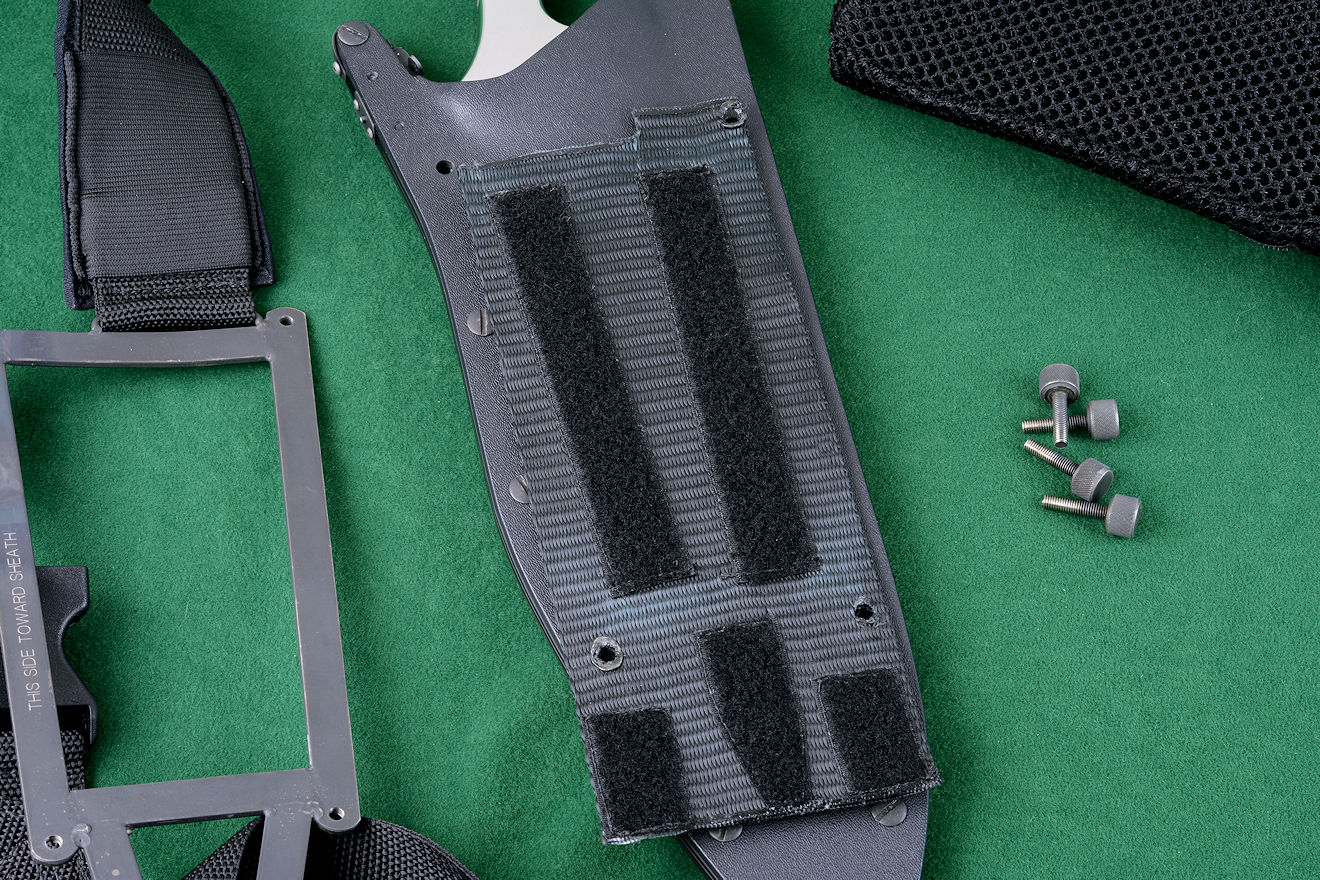
The anchor pad has holes that line up with the modular frame mounting holes. In this case only three holes are used, and there is a cut-out in the upper left area for clearance of the different loops in the frame.
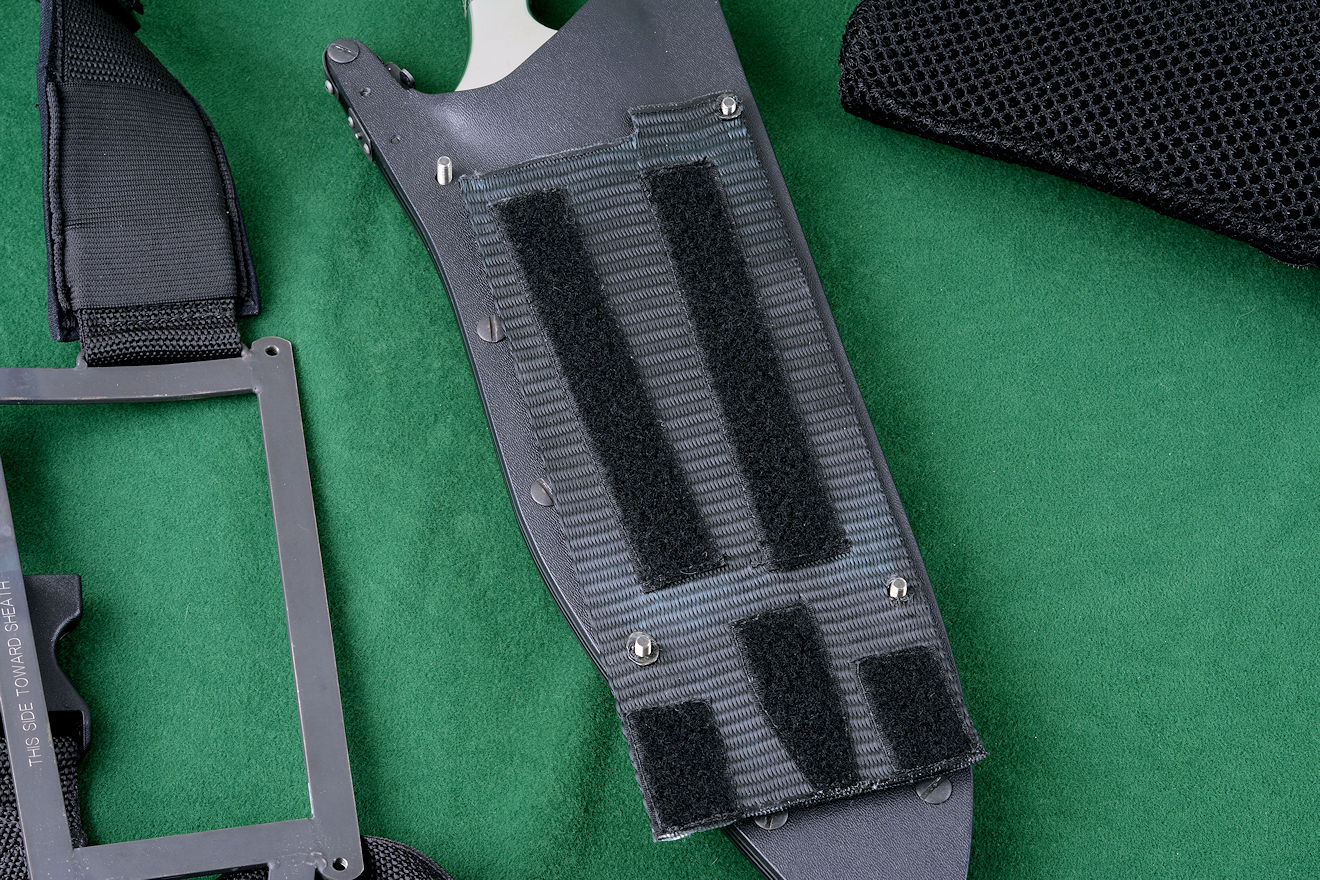
Above, the longer thumbscrews are used in mounting the mesh anchor and the frame. This extra length accommodates the thicker anchor and the increase in thickness of the sheath. Detailed video.
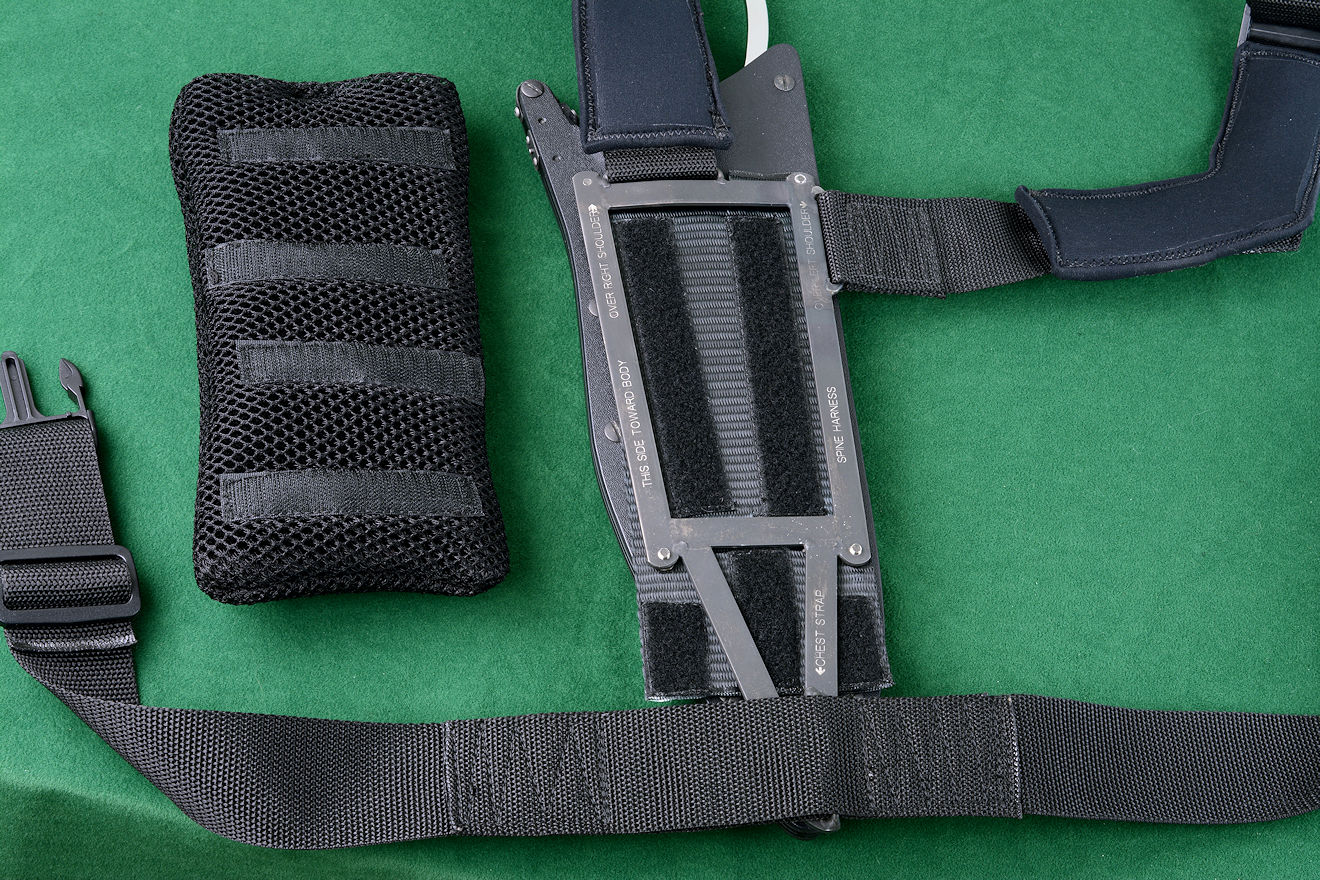
The anchor and modular frame unit are mounted. The loop component of the hook and loop attachment is between the frame members so that the mesh pad can be easily attached with hand pressure. Once attached, it will not move, since it's trapped between the body and the sheath and frame, and since the hook and loop is highly resistant to shear (sideways) movement.
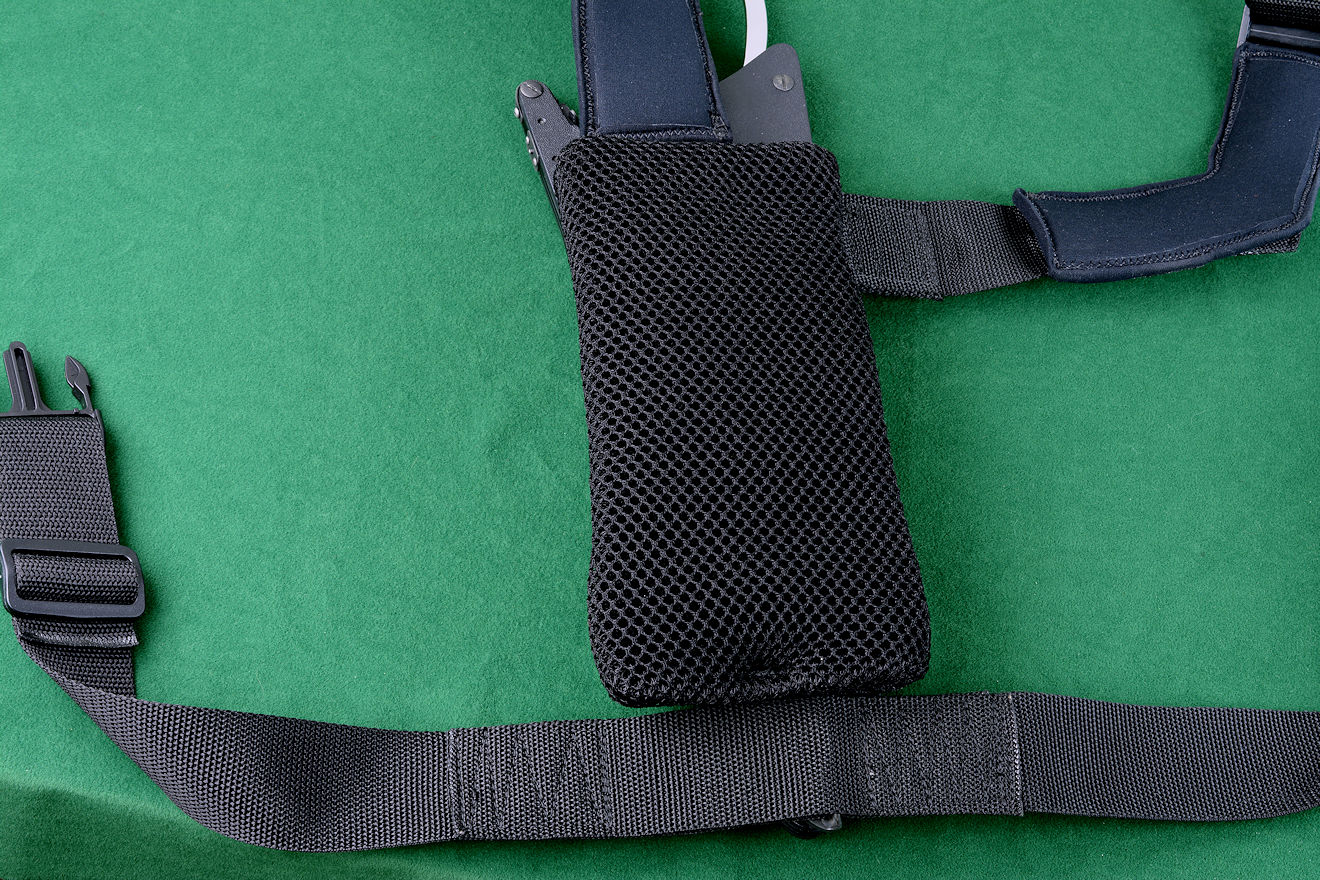
Above, the ventilated pad is mounted. It has no specific direction to mount, simply placed and pressed against the sheath back. The sizes of the various modules are all very similar, and since they are interchangeable, so is the ventilated mesh padding. This is a very comfortable and breathable assembly, and the padding is cool and light. Detailed video.
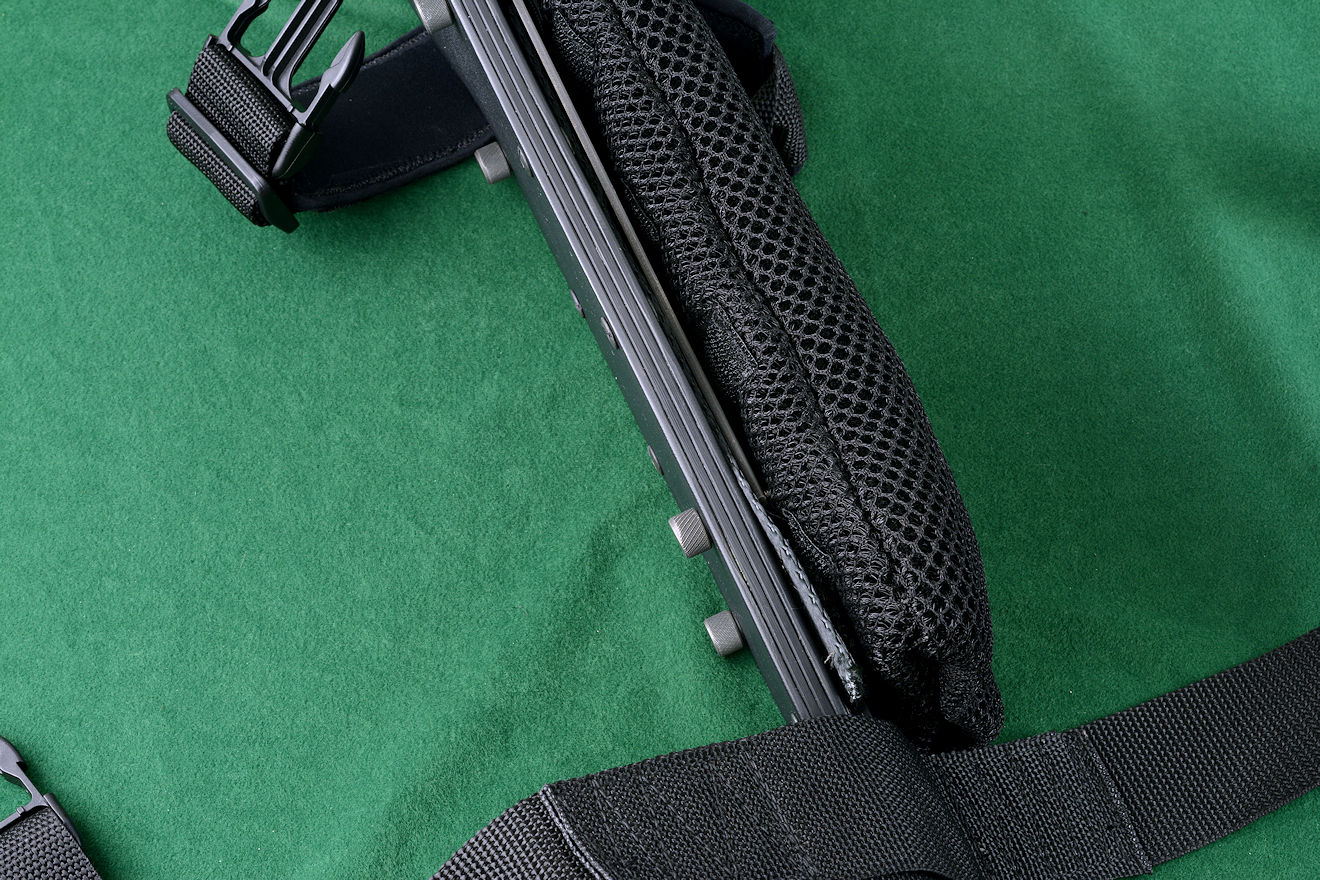
In this photo, you can see the thickness of the padding. It compresses somewhat into an overall thickness of about 3/4" (2 cm), but allows plenty of air between the body and the sheath.

Thanks, S. H.!
| Main | Purchase | Tactical | Specific Types | Technical | More |
| Home Page | Where's My Knife, Jay? | Current Tactical Knives for Sale | The Awe of the Blade | Knife Patterns | My Photography |
| Website Overview | Current Knives for Sale | Tactical, Combat Knife Portal | Museum Pieces | Knife Pattern Alphabetic List | Photographic Services |
| My Mission | Current Tactical Knives for Sale | All Tactical, Combat Knives | Investment, Collector's Knives | Copyright and Knives | Photographic Images |
| The Finest Knives and You | Current Chef's Knives for Sale | Counterterrorism Knives | Daggers | Knife Anatomy | |
| Featured Knives: Page One | Pre-Order Knives in Progress | Professional, Military Commemoratives | Swords | Custom Knives | |
| Featured Knives: Page Two | USAF Pararescue Knives | Folding Knives | Modern Knifemaking Technology | My Writing | |
| Featured Knives: Page Three | My Knife Prices | USAF Pararescue "PJ- Light" | Chef's Knives | Factory vs. Handmade Knives | First Novel |
| Featured Knives: Older/Early | How To Order | Khukris: Combat, Survival, Art | Food Safety, Kitchen, Chef's Knives | Six Distinctions of Fine Knives | Second Novel |
| Email Jay Fisher | Purchase Finished Knives | Serrations | Hunting Knives | Knife Styles | Knife Book |
| Contact, Locate Jay Fisher | Order Custom Knives | Grip Styles, Hand Sizing | Working Knives | Jay's Internet Stats | |
| FAQs | Knife Sales Policy | Concealed Carry and Knives | Khukris | The 3000th Term | Videos |
| Current, Recent Works, Events | Bank Transfers | Military Knife Care | Skeletonized Knives | Best Knife Information and Learning About Knives | |
| Client's News and Info | Custom Knife Design Fee | The Best Combat Locking Sheath | Serrations | Cities of the Knife | Links |
| Who Is Jay Fisher? | Delivery Times | Knife Sheaths | Knife Maker's Marks | ||
| Testimonials, Letters and Emails | My Shipping Method | Knife Stands and Cases | How to Care for Custom Knives | Site Table of Contents | |
| Top 22 Reasons to Buy | Business of Knifemaking | Tactical Knife Sheath Accessories | Handles, Bolsters, Guards | Knife Making Instruction | |
| My Knifemaking History | Professional Knife Consultant | Loops, Plates, Straps | Knife Handles: Gemstone | Larger Monitors and Knife Photos | |
| What I Do And Don't Do | Belt Loop Extenders-UBLX, EXBLX | Gemstone Alphabetic List | New Materials | ||
| CD ROM Archive | Independent Lamp Accessory-LIMA | Knife Handles: Woods | Knife Shop/Studio, Page 1 | ||
| Publications, Publicity | Universal Main Lamp Holder-HULA | Knife Handles: Horn, Bone, Ivory | Knife Shop/Studio, Page 2 | ||
| My Curriculum Vitae | Sternum Harness | Knife Handles: Manmade Materials | |||
| Funny Letters and Emails, Pg. 1 | Blades and Steels | Sharpeners, Lanyards | Knife Embellishment | ||
| Funny Letters and Emails, Pg. 2 | Blades | Bags, Cases, Duffles, Gear | |||
| Funny Letters and Emails, Pg. 3 | Knife Blade Testing | Modular Sheath Systems | |||
| Funny Letters and Emails, Pg. 4 | 440C: A Love/Hate Affair | PSD Principle Security Detail Sheaths | |||
| Funny Letters and Emails, Pg. 5 | ATS-34: Chrome/Moly Tough | ||||
| Funny Letters and Emails, Pg. 6 | D2: Wear Resistance King | ||||
| Funny Letters and Emails, Pg. 7 | O1: Oil Hardened Blued Beauty | ||||
| The Curious Case of the "Sandia" |
Elasticity, Stiffness, Stress, and Strain in Knife Blades |
||||
| The Sword, the Veil, the Legend |
Heat Treating and Cryogenic Processing of Knife Blade Steels |